






Owen Phairis (KB6CGZ) - Owner - Director - Curator
(909) 806-5698 (Call or Text)
Big Bear Lake, California
Planetarium Projector Props Available for Television and Movie Production

Learn about our fearless Planetarium Curator
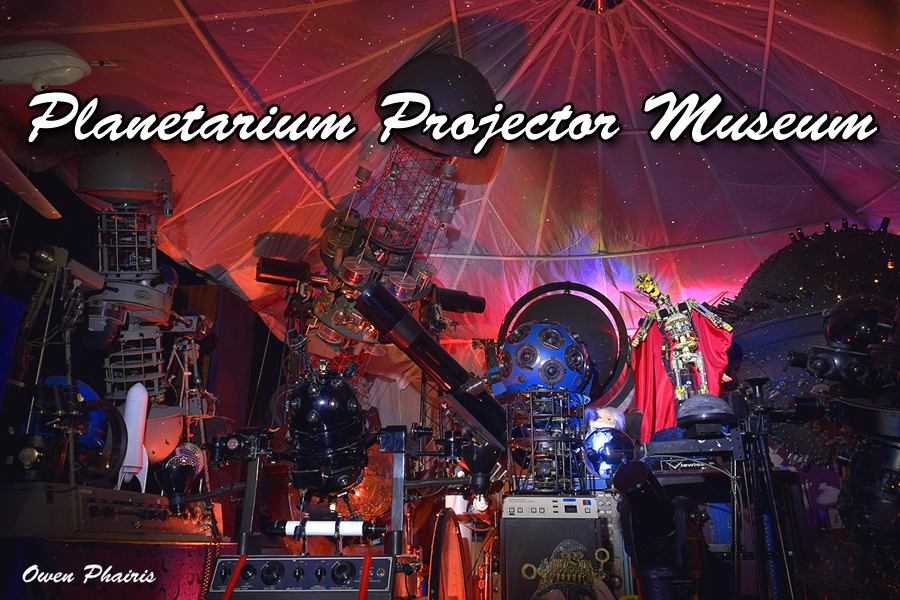
Planetarium Projector Based Picture Gallery



Stereo 3-Dimensional Photograph of Spitz A-1 Planetarium Projector
This 3-D anaglyph image requires standard Red (left eye) / Blue (right eye) 3-D glasses.
Many more exciting 3-D projector images may be found by clicking on the above image.
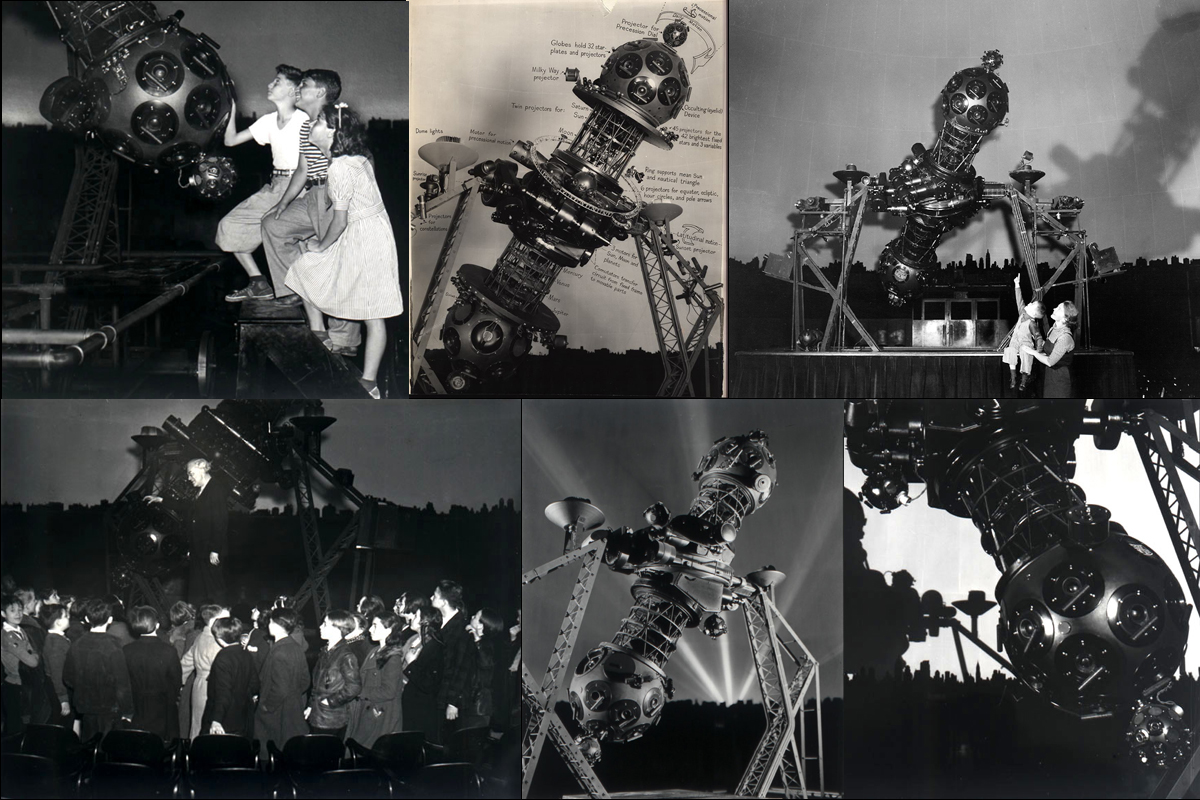
PLANETARIUM PICTURE SCRAPBOOK
Containing many Historical Zeiss Projector Photographs
The Museums' Telescope Collection and Planetaria

"Preserving our Planetarium Past for our Future
to the Benefit of All Planetariums Everywhere"
The only place to come and study the history, design, construction and evolution of Planetarium Projectors.
Where preservation, display, and education about our historic and rare Planetarium Projectors is our main mission.
We collect Planetarium Projectors for Display and Preservation.
Where we cherish the old technology, but also appreciate the new technologies.The most valuable acquistion of the Planetarium Projector Museum is the enthusiasm it invites.
Introducing the Public to Planetarium Science and Engineering
Inspirational Today and Legendary Tomorrow
A Museum of Imagination and Inspiration
Owen Phairis: Owner, Director & Curator (909-806-5698)
J.R. Phairis and Owen Phairis IV: Trustees and Directors of Logistics
The only place in the Universe to visit the Worlds' largest collection of Planetarium Projectors!
We would like to make the Planetarium Projector Collection Available as a Traveling Science Exhibit
for Planetariums and Museums across the Country!
FEATURING:
* The Planetarium Projector Hall of Fame *
From the Golden Age of Planetarium Projectors
Starring An Astronomical Collection of Antique
Planetarium
Projector Instruments from Theaters of the Stars!
Current Museum Inventory of Planetarium Projectors
(January 2020)
Zeiss ZKP 3B
(2) Spitz A1s
Spitz A2
Spitz A3-P
Spitz 373
Spitz 512
Spitz STP
Spitz STS
Spitz STS Prototype
Goto S2
Goto E-5
Goto EX-3
Goto Mercury
(2) Goto Venus
Goto Viewlex Apollo
Musser Prototype
Minolta Series IIB
Harmonic Reed Nova III
Dick Emmons Homemade


New to the Museum (March 2020) is this IBM-1620 Computer.
Designed in 1959, it is currently being upgraded at the Museum.

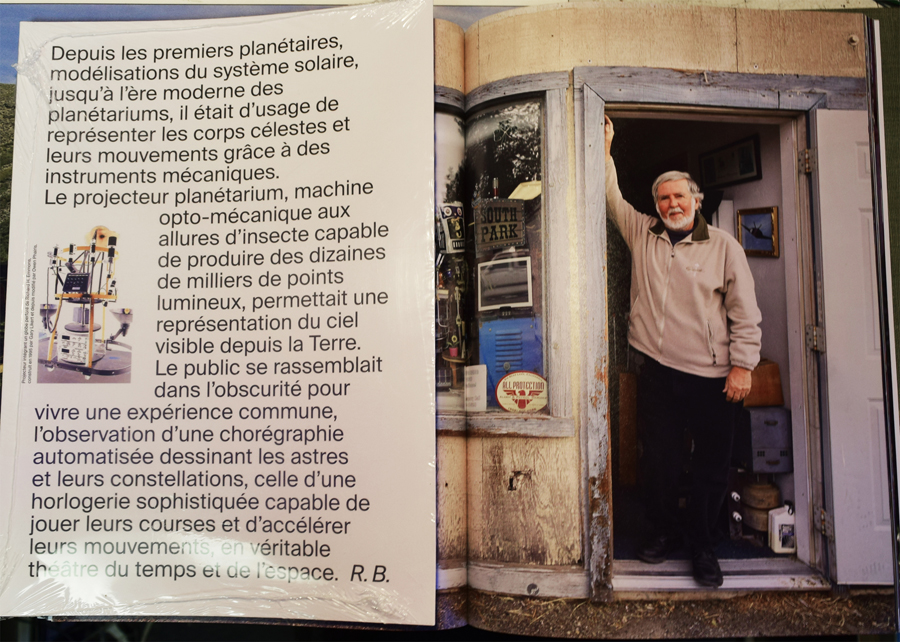
In 2015 I had a wonderful visit from Remi Bragard who came all the way from France to visit my Planetarium Museum. He spent 3 days with me taking pictures of all my projectors and yesterday, September 21 2019, I received an autographed copy of his new planetarium book. It features around 27 pages of photographs from my Museum, and even includes a picture of me in the Museum doorway. The book also includes my friend Gary Likert.


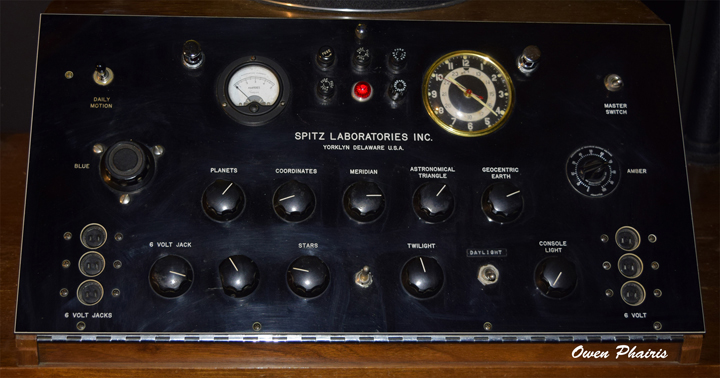
The newest (July 2019) addition to our Planetarium is this wonderful Spitz A2 Planetarium Projector.
This beautiful Spitz A-2 projector was generously donated by Brad Snowder of Washington.
The projector was most recently on display at the Electrical History Museum and was the projector used by the
Spanel Planetarium at Western Washington University from 1959 till 2004 where Brad was the Planetarium Director.

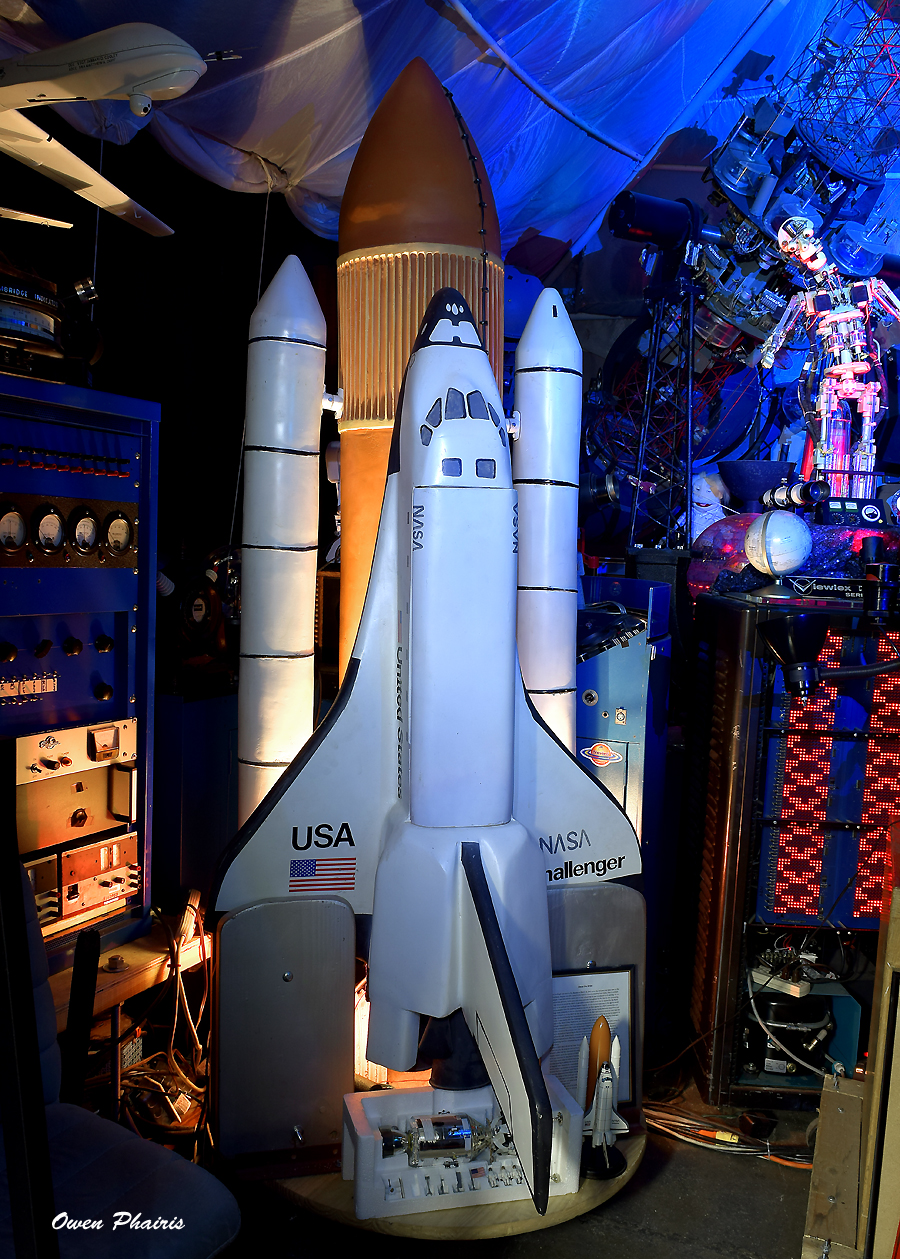
The newest (April 2017) addition to our Planetarium is this large 8 foot tall 1/25 scale model of the Space Shuttle Challenger.
It comes to us from Dr. Lonnie Hammargrens' Planetarium in Las Vegas, Nevada.

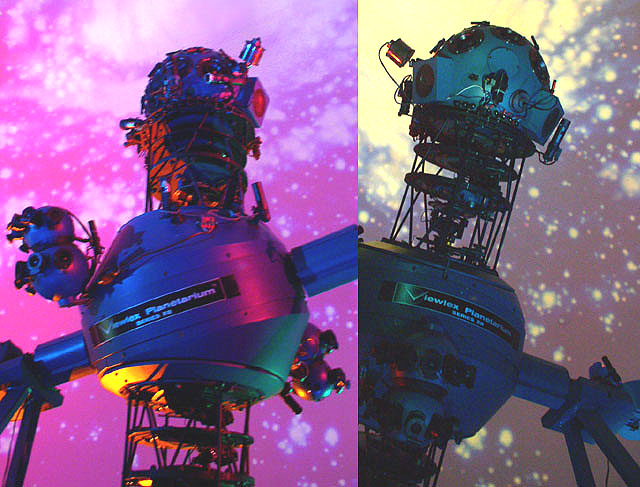
Museums' Minolta Series II B Planetarium Projector
The Planetarium Projector Museum is indeed fortunate and very proud to receive the donation of a Viewlex Minolta Series II B planetarium projector.
This projector is a generous donation to the Museum from the Robert J. Novins Planetarium located in Toms River New Jersey.
Gallery of Minolta Series IIB Planetarium Projector Pictures.
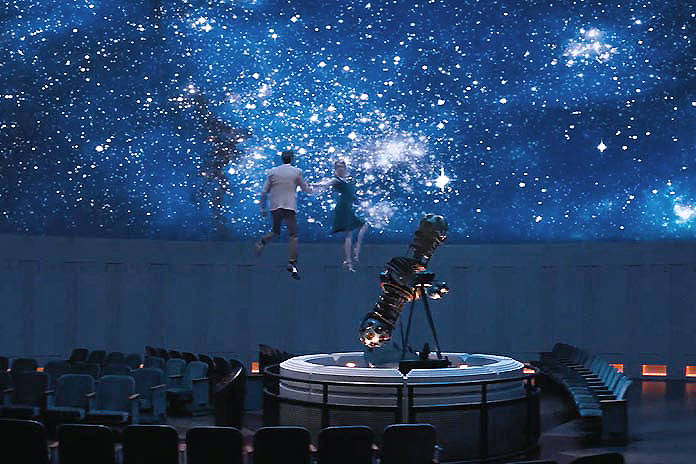
Our Projector was used in the filming of the movie "La La Land."
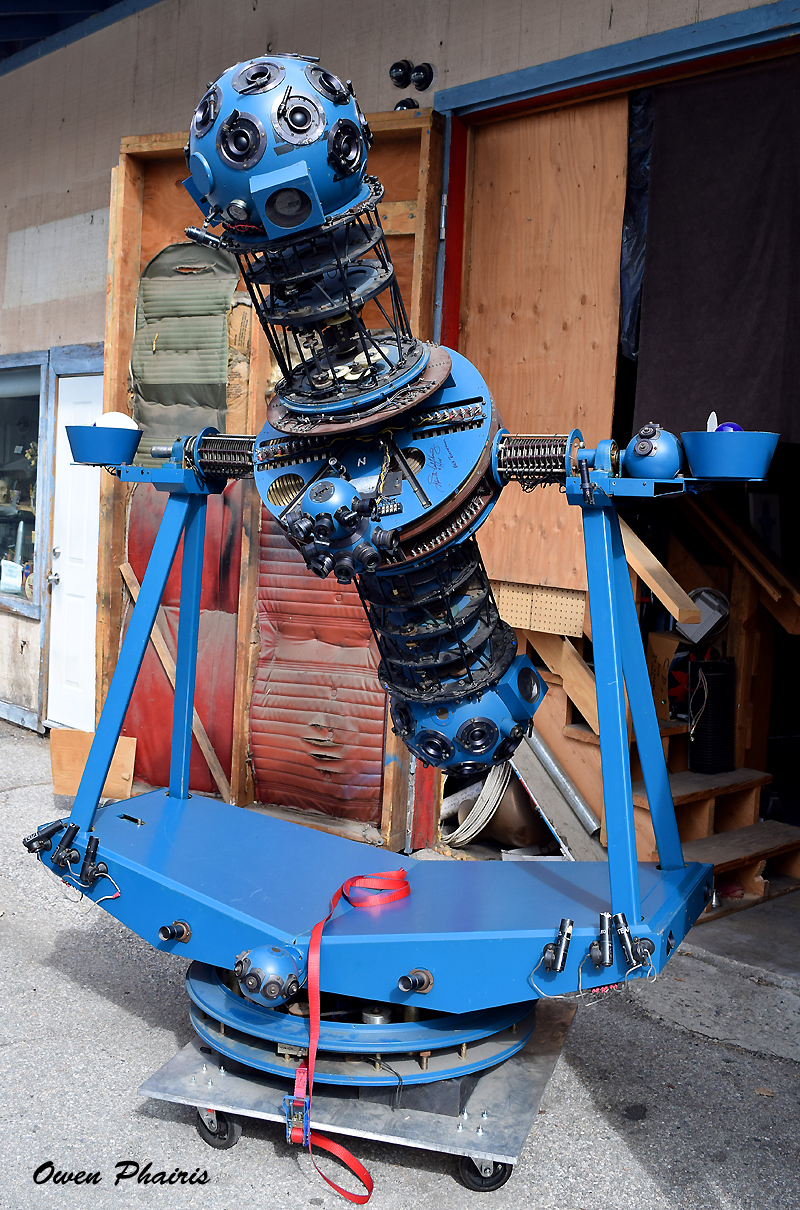
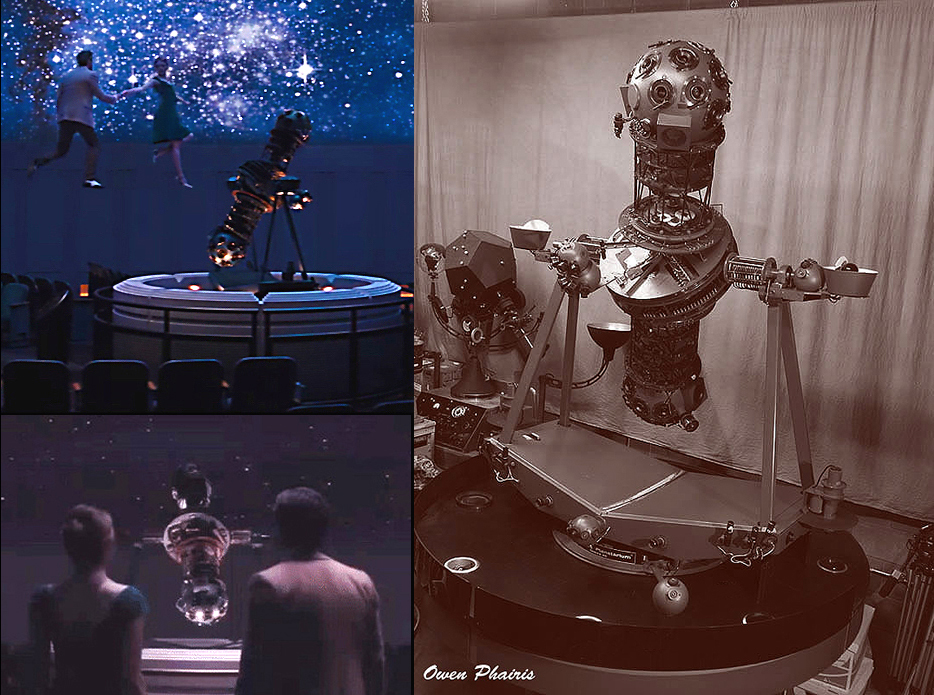
Museums' Minolta Projector
This 1974 vintage planetarium projector originally cost $ 110,000.00 and is capable of optically generating over 4,000 stars on a 40 foot dome. The projector arrived at the Museum in late August 2008 and we just completed her restoration. Pictures of the restoration process on this marvelous projector have been posted on the Planetarium Picture Scrap Book pages of this website. This projector was rented to Universal Studios for a March 15th 2010 episode of the Fox Tv series "House." This projector is also featured in the full length theatrical movie "La La Land" which stars Emma Stone and Ryan Gosling and was released in December 2016.

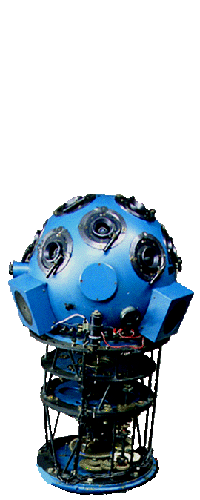
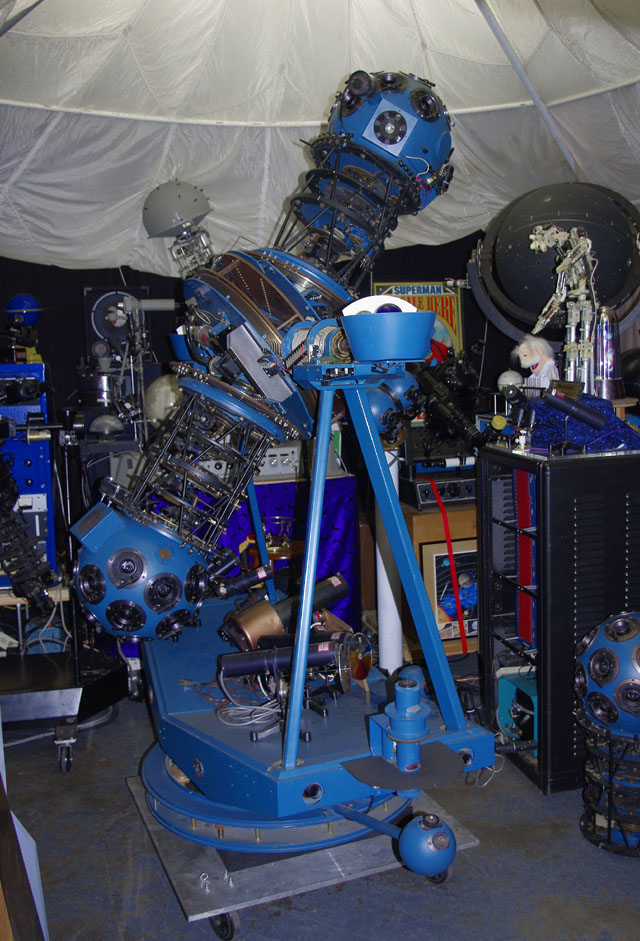

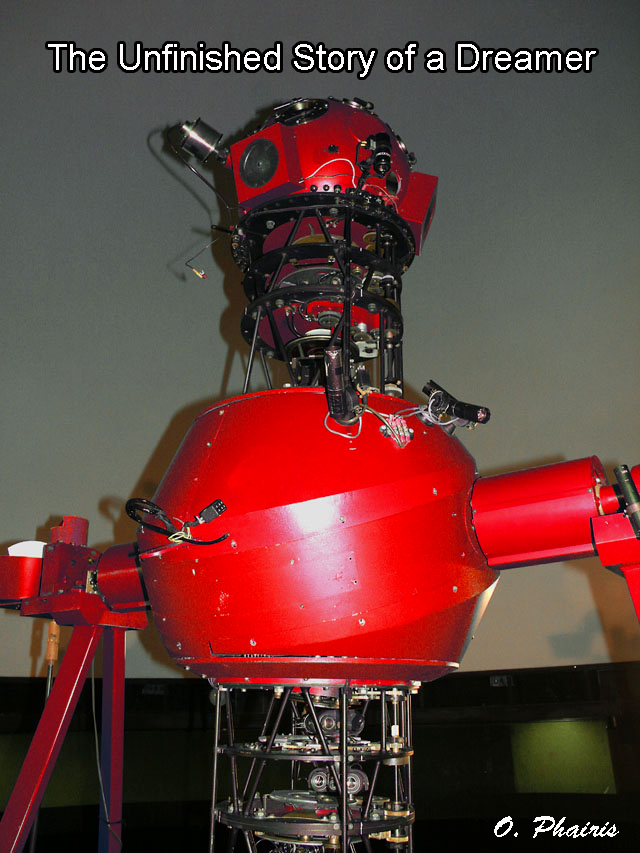

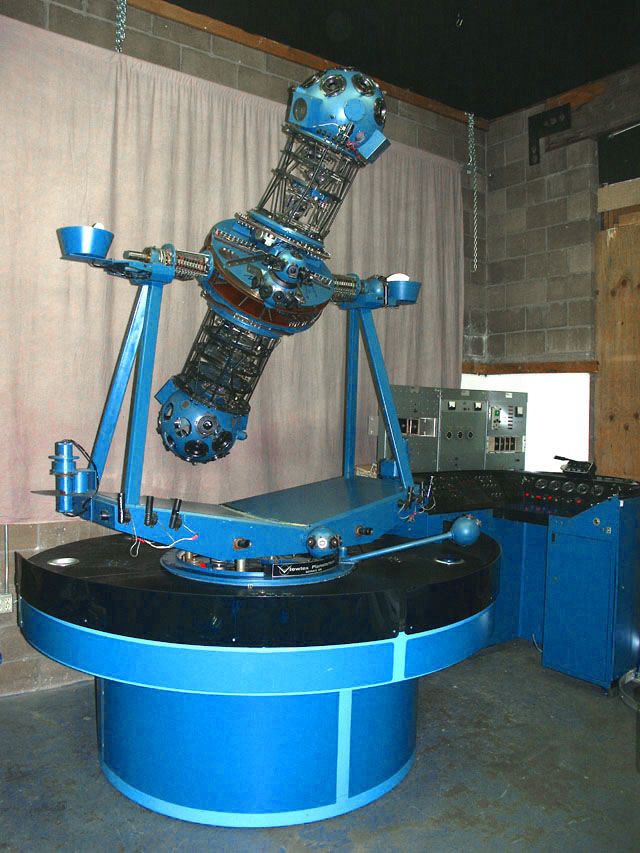

Minolta Projector after Restoration at the Museum
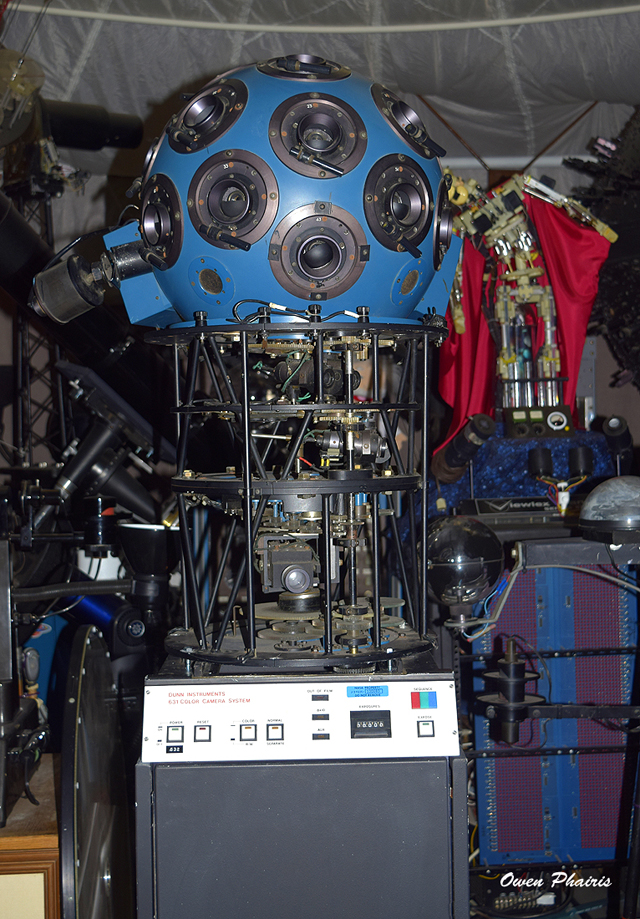
Spare Minolta Starball and Planet Cage mounted on a pedestal for display

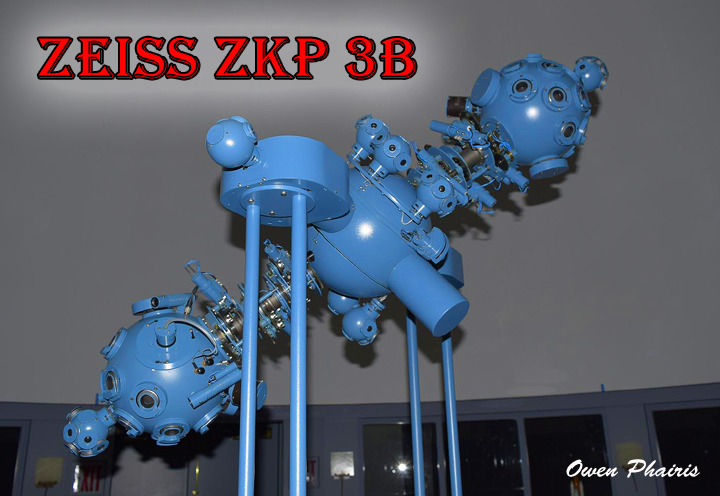
Athena Zeiss Daughter of Zeus
(In Greek Mythology Athena is the Virgin Goddess of Wisdom, Courage, Inspiration, Mathematics, and the Arts)
I purchased a Zeiss ZKP-3B Planetarium Projector which we named "Athena" to add to the Museum Collection!
The Zeiss Skymaster ZKP-3B shows everything in the sky one might see on a clear night under perfect viewing conditions. It projects over 7,000 individual stars in addition to star clusters, nebulae, galaxies, the Milky Way, the Sun and the Moon, in addition to the 5 visible planets. It also projects line drawings that outline the major constellations. The computer controlled projector also functions a lot like a time machine by recreating our night sky at any location on Earth for any moment in history, either in the past or the future. This projector came to us from the Dreyfuss Planetarium located in the Newark Museum, Newark New Jersey.
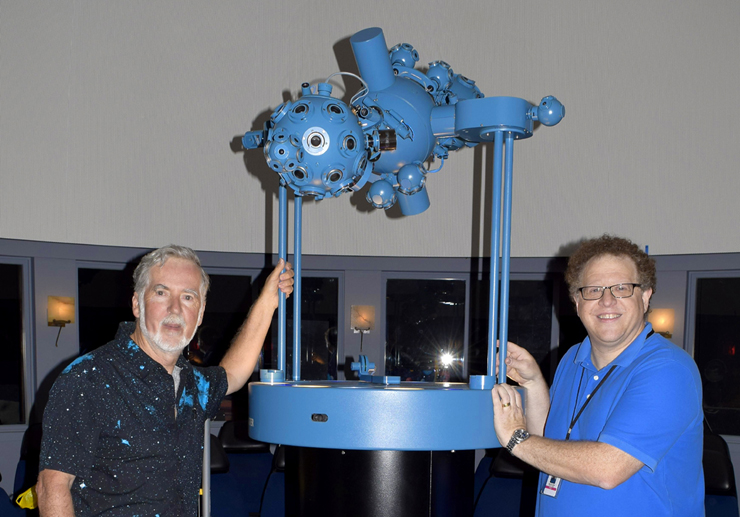
Pictured here with me is Kevin Conod, Director of the Dreyfuss Planetarium at the Newark NJ Museum.
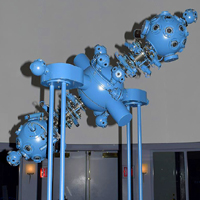
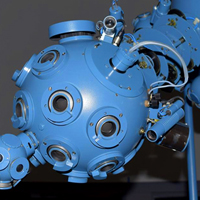
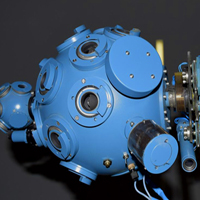

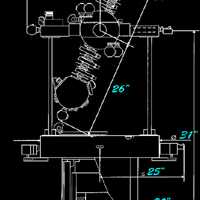
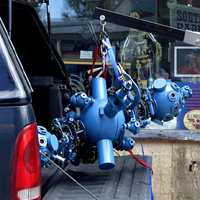
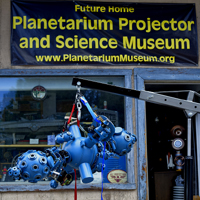
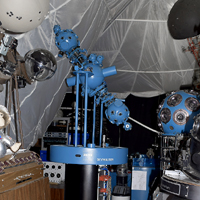
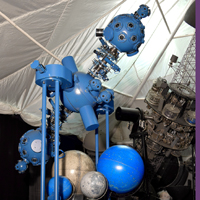
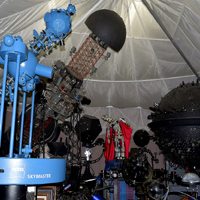
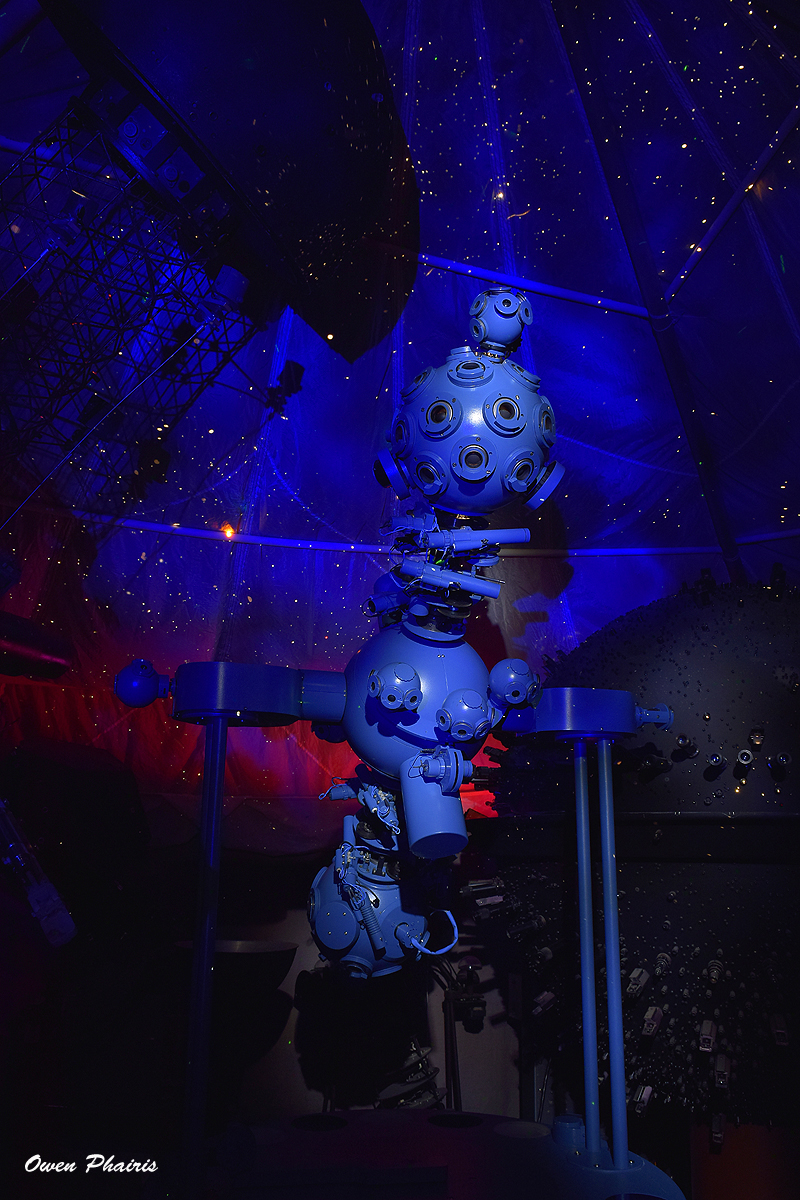
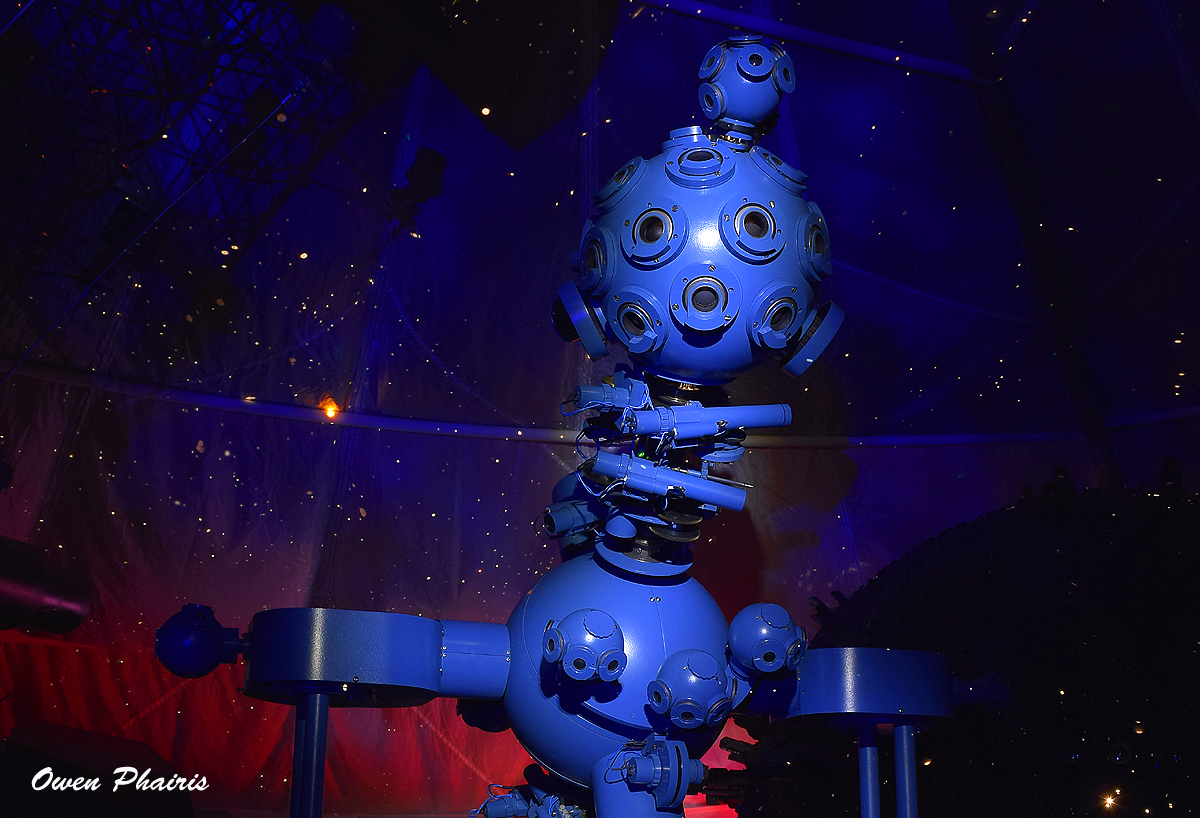
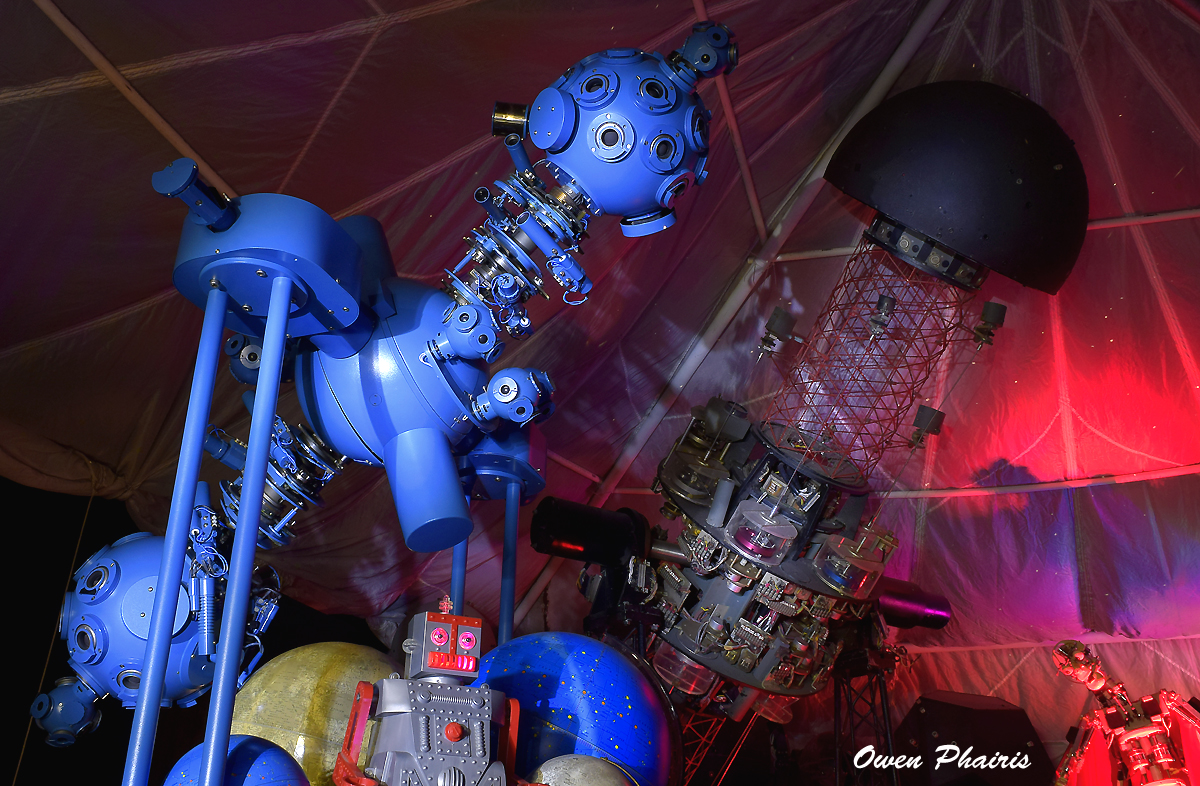

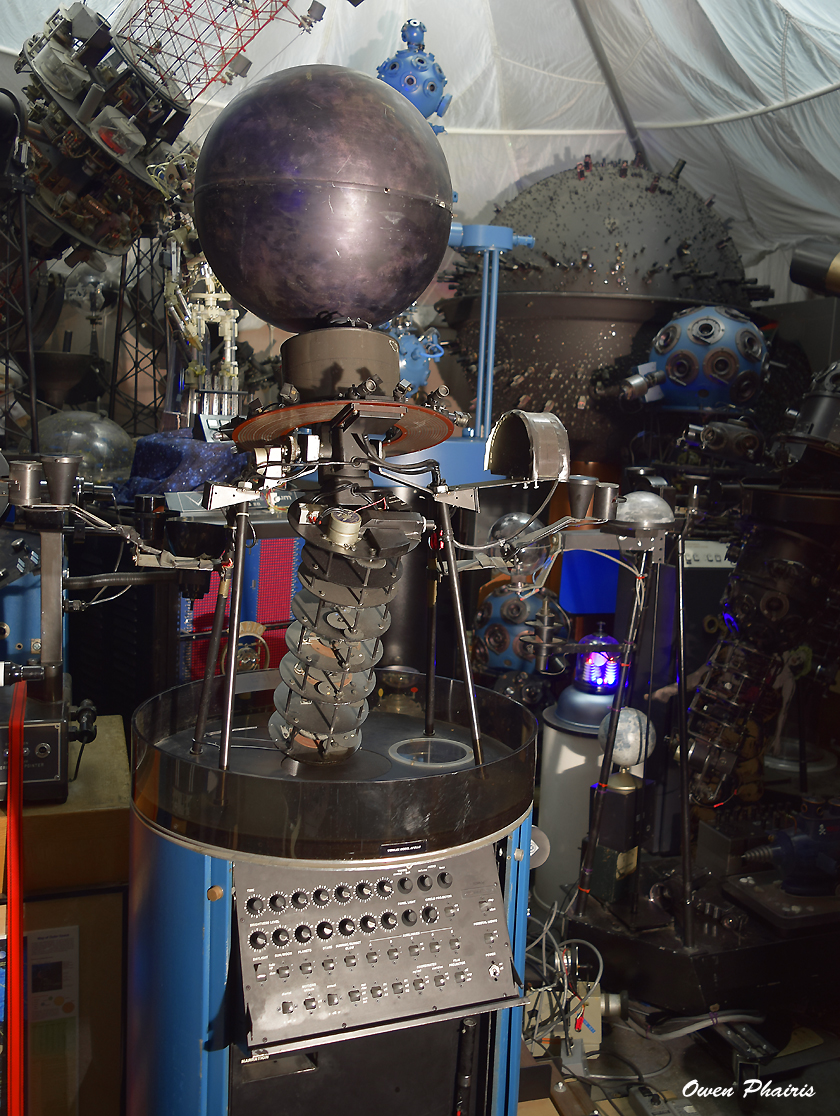
Goto Viewlex Model Apollo Planetarium Projector
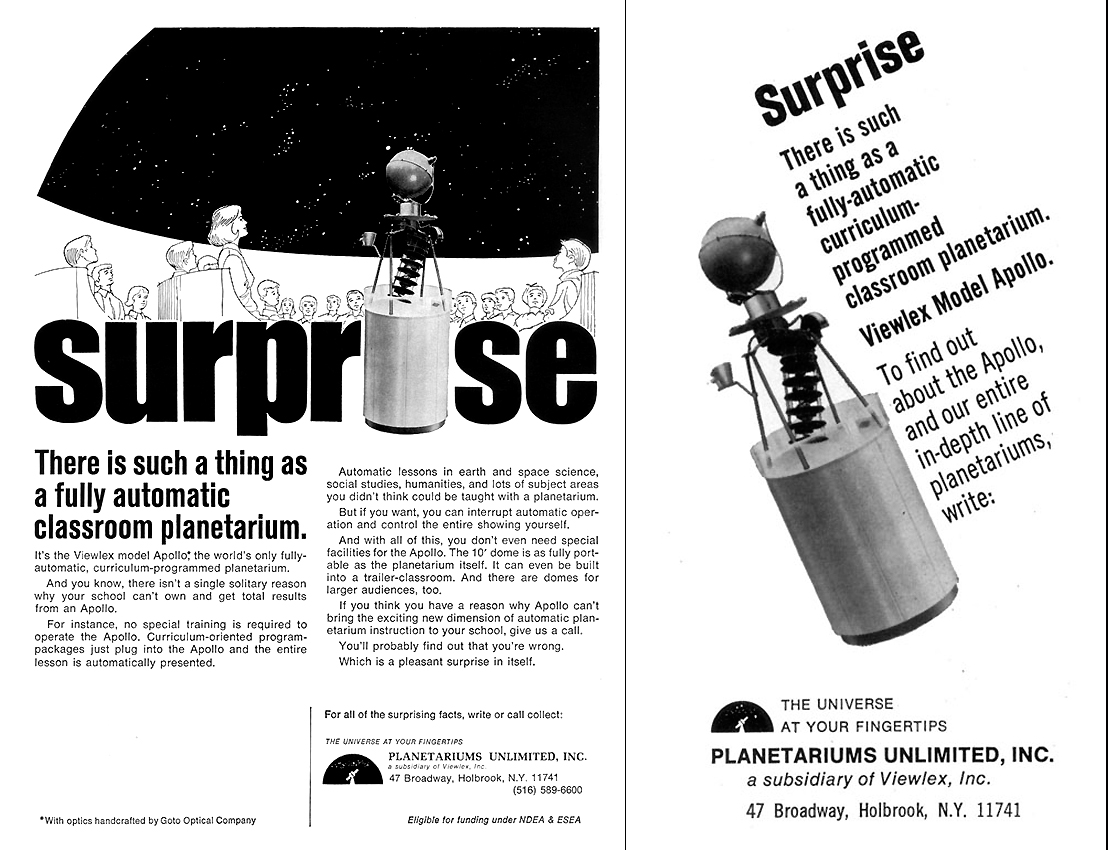
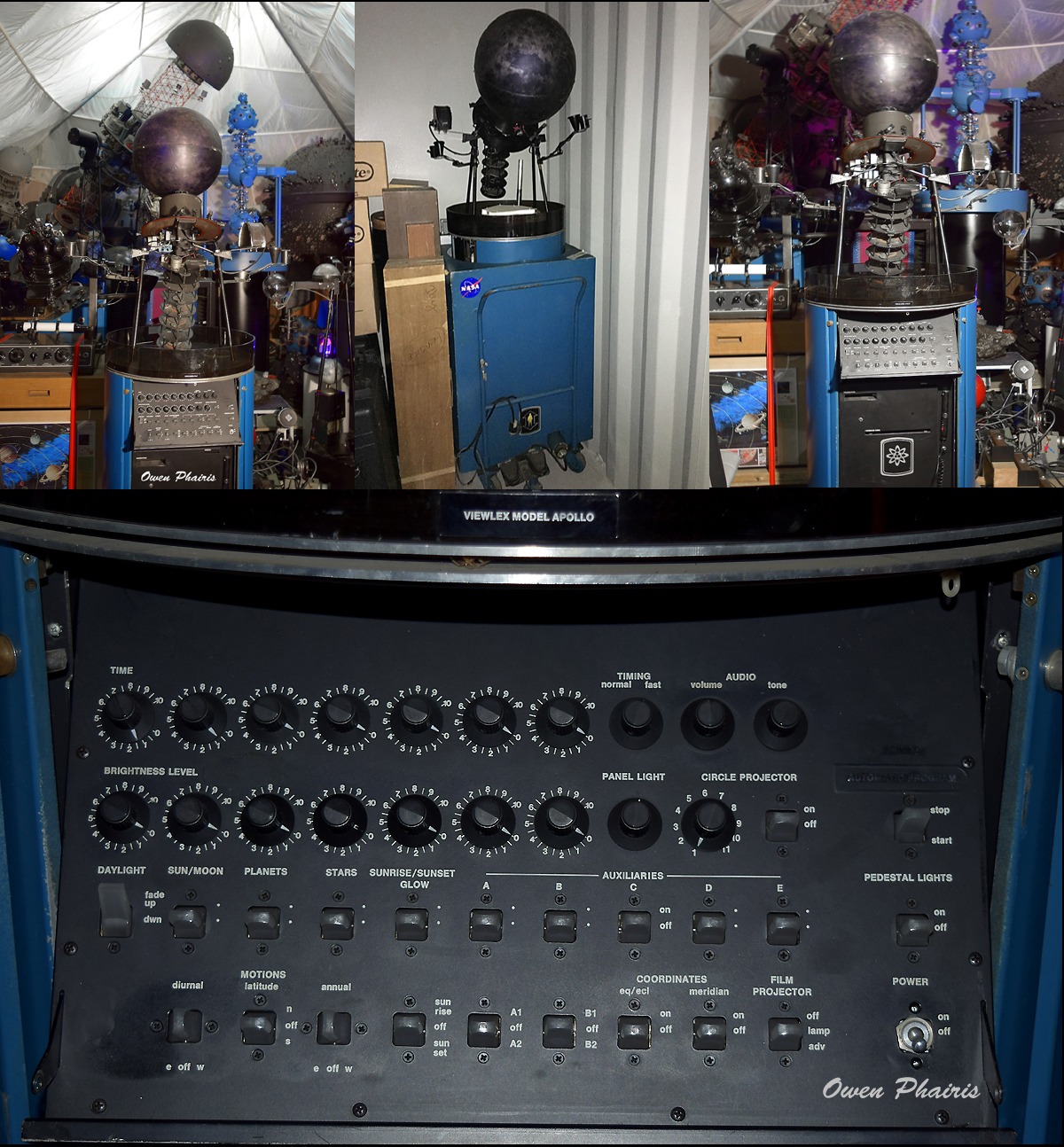
Our newest Goto Planetarium Projector was used at Orange Coast College and arrived at the Museum on February 1, 2017.
This is a rare (1973 serial # 3) Goto Viewlex Apollo Projector with a 16" diameter starball and an electrically operated hydraulic elevator.

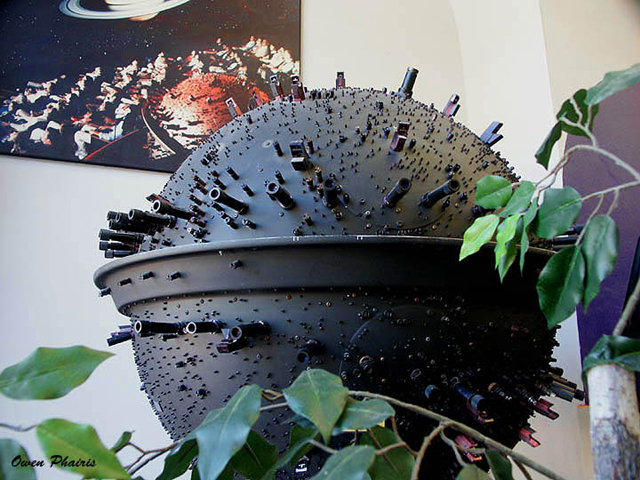
Spitz STS/Voyager Planetarium Projector
A new edition to the Museum collection is this wonderful Spitz Space Transit Simulator (STS) from the Reuben H. Fleet Planetarium located in Balboa Park, San Diego, California. This was the very first STS projector ever built by Spitz and first saw service in March 1973. It was in service for 25 years and projected 10,000 stars on a 76 foot tilted dome.
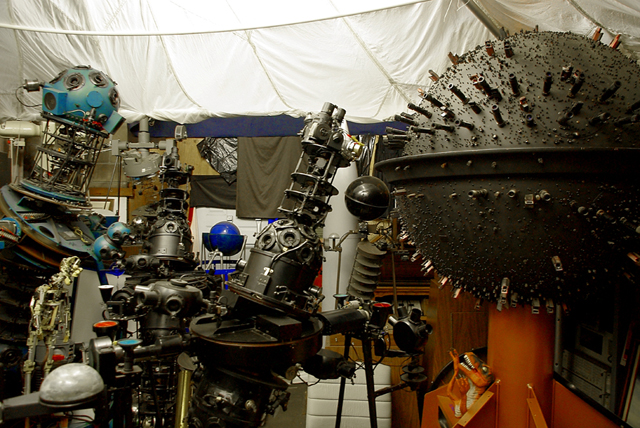
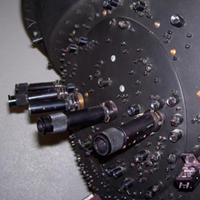
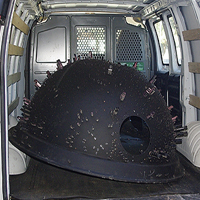
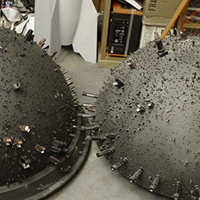
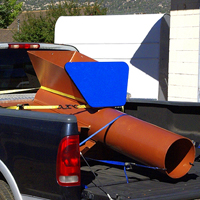
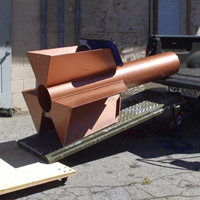

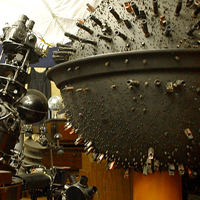
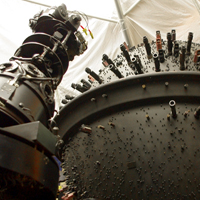
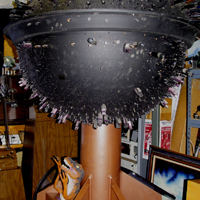
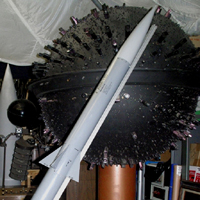
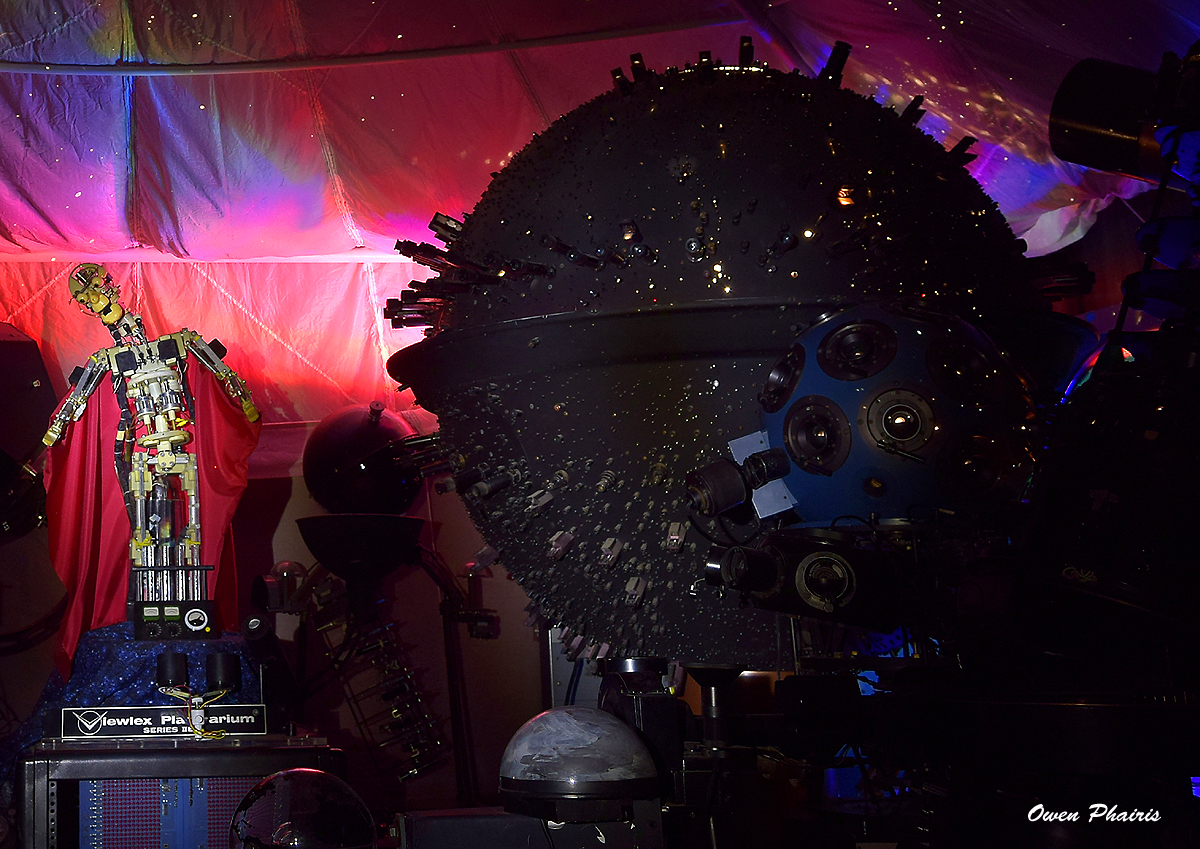

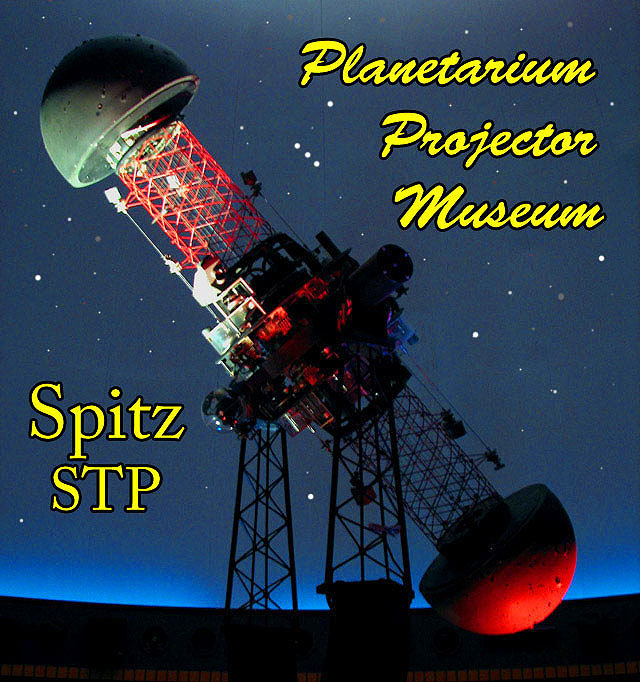
Museums' Spitz STP Planetarium ProjectorThis magnificent projector is one of only 11 ever made by Spitz. This projector was purchased from The Gengras Planetarium at The Children's Museum in Connecticut and is affectionately known by the name of Stella. She completed nearly 40 years of continuous service and educated over 1,000,000 people before being replaced by an all new digital planetarium system. She is capable of generating over 4,000 stars and all the visible planets. This machine is currently at the Museum and is on display. Here is a list of the 11 STPs that were built and where they originally went to: Houston, Trenton, Salt Lake City, Abrams at Michigan State, Bradenton's Bishop Planetarium, Yonkers, Denver, Hartford, Warminster, Montgomery and the last operating STP in Miami went dark in 2015.
Gallery of Spitz STP Planetarium Projector Pictures.
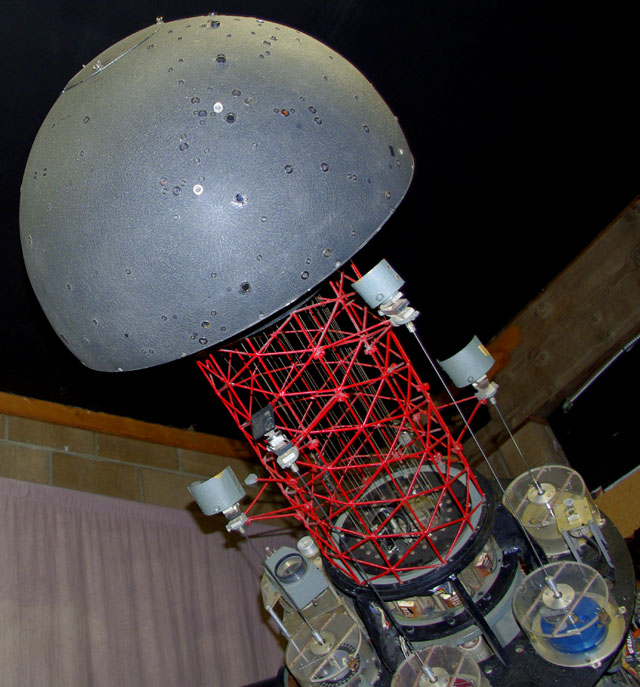
Stella our Spitz STP Projector being Restored
Some interesting facts about the STP projector. It was the first commercial projector to have a third (yaw) axis and the very first to be computer controlled. It projects over 4,000 stars to magnitude +5.8 and all stars greater than 3.5 are projected using 260 separate lenses. It uses two 75 watt arc lamps for light sources for projection on a 40 to 65 foot dome. There are 10 analogs versus 7 as in the popular A3P. There is a separate analog for the Earth which was needed because this was the very first projector that would allow you to place the audience on the moon or other location in outer space. There are also two analogs for the sun (mean and true) which makes demonstrating the equation of time not only possible but also easier to visualize.
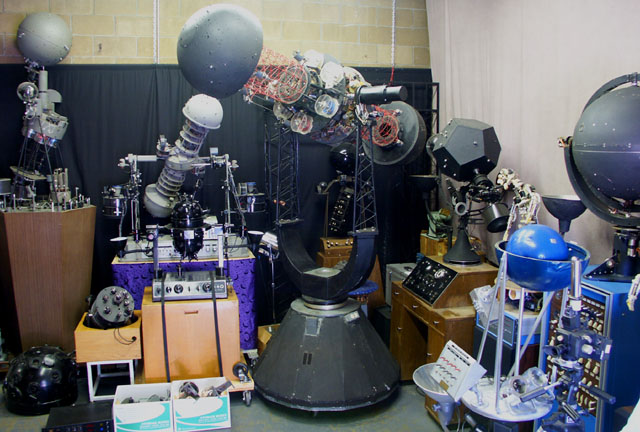
Photograph of Stella and our Planetarium Collection
Some more interesting facts about the STP projector. Each instrument requires 43 motors, over 12 miles of electrical wiring and more than 6,000 electrical connections. Total package price installed was around $ 146,575.00 with a 40 foot dome way back in 1963. This projector also has zooming earth and zooming moon projectors installed so during a planetarium program they could take visitors on a space flight and safely return.
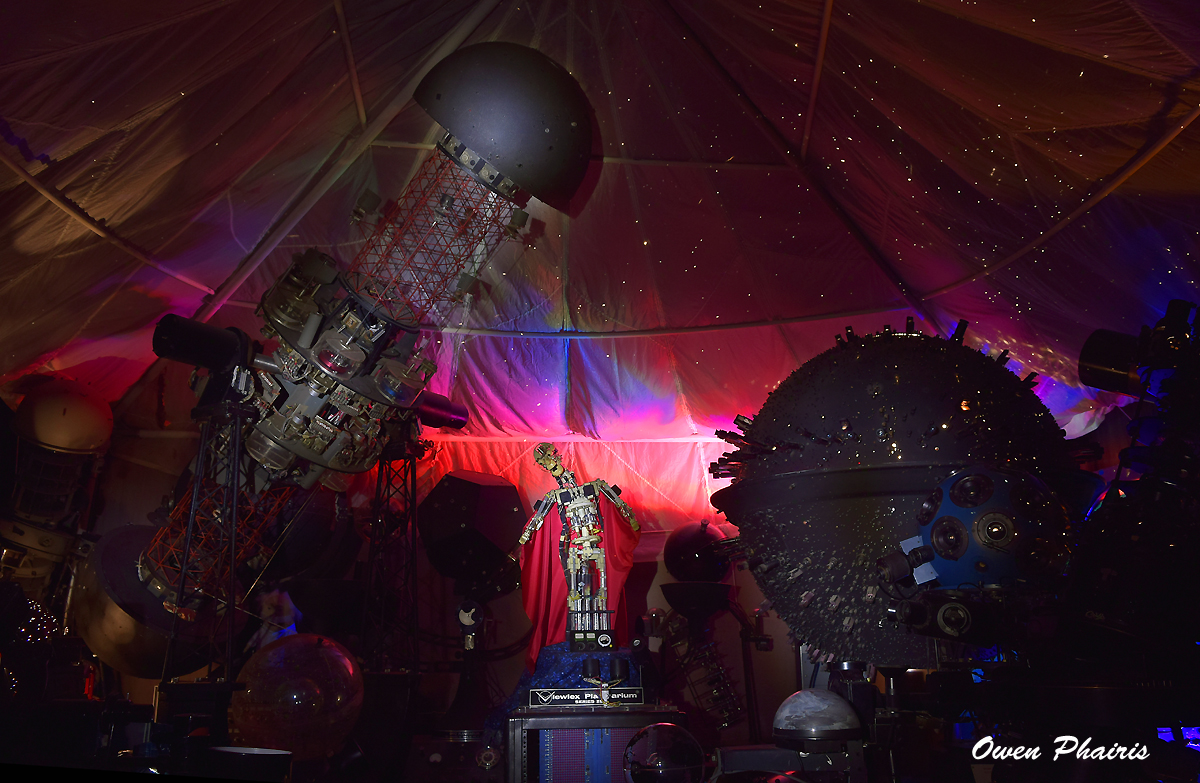
Spitz STP and Spitz STS Planetarium Projectors

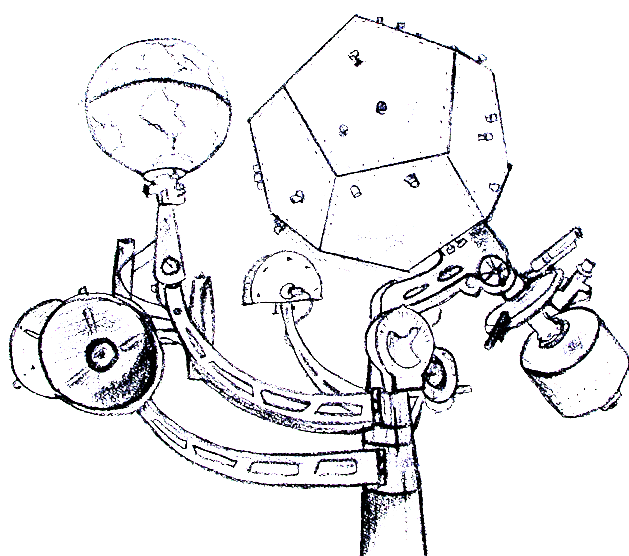
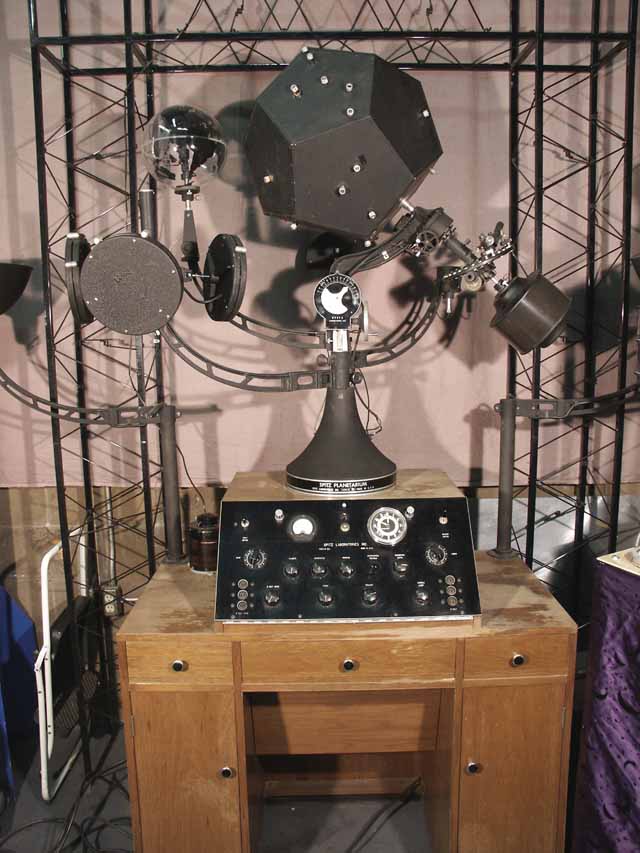
Museums' Spitz A-1 Planetarium Projector
This projector was used at the University of Michigian. This one is Serial Number #131 and Code # A1 300.
It is one of about only 40 ever made before they started making the A2 and I believe this one was built in 1953.
Gallery of Spitz A1 Planetarium Projector Pictures.
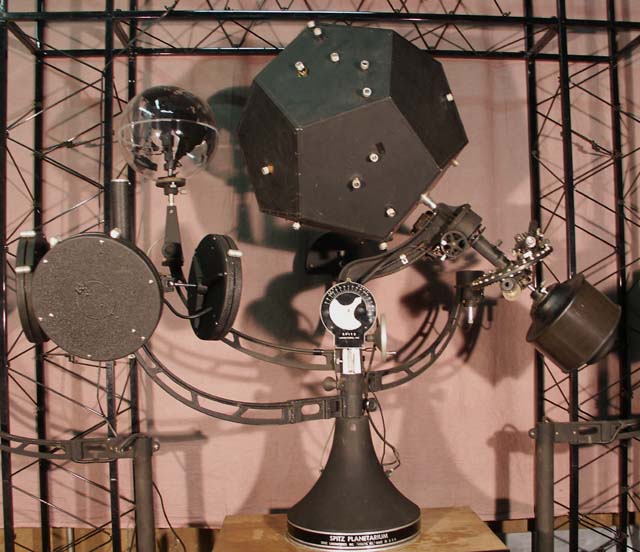
Closeup Spitz A-1 Planetarium Projector
Pictured accessories include the astronomical triangle used for teaching celestial navigation on the left. Also to the left is the geo-centric earth projector. In the back, barely visible, is the meridian projector and also the twilight projector. The co-ordinate projector is on the far right and the planet projectors between it and the dodecahedron star globe.
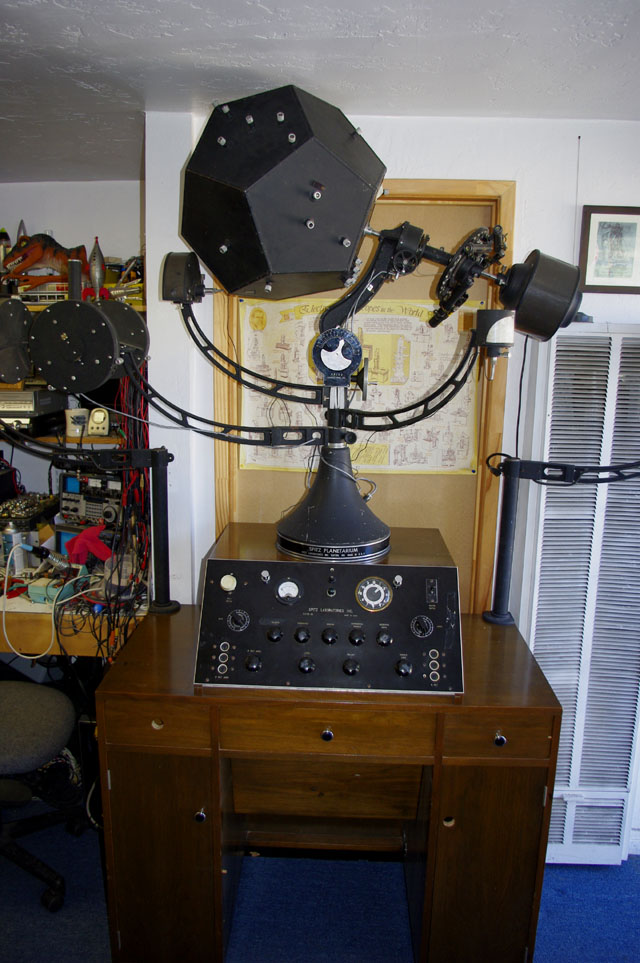
Museums' newest and second Spitz A1 Planetarium Projector
In our continuing effort to preserve our rich planetarium heritage, the Museum is proud to announce the purchase of a second Spitz A1 Planetarium Projector with all the acessories for the Collection. This one is an A-1 300A and is Serial Number 122 and was originally sold to and used at the Museum of History and Science at Waterloo, Iowa. The projector arrived safely here at the Museum on July 4th 2010 and came to us from the Jacksonville High School in Jacksonville, Illinois. It is setup temporarily in the front office till a better location may be found for it.
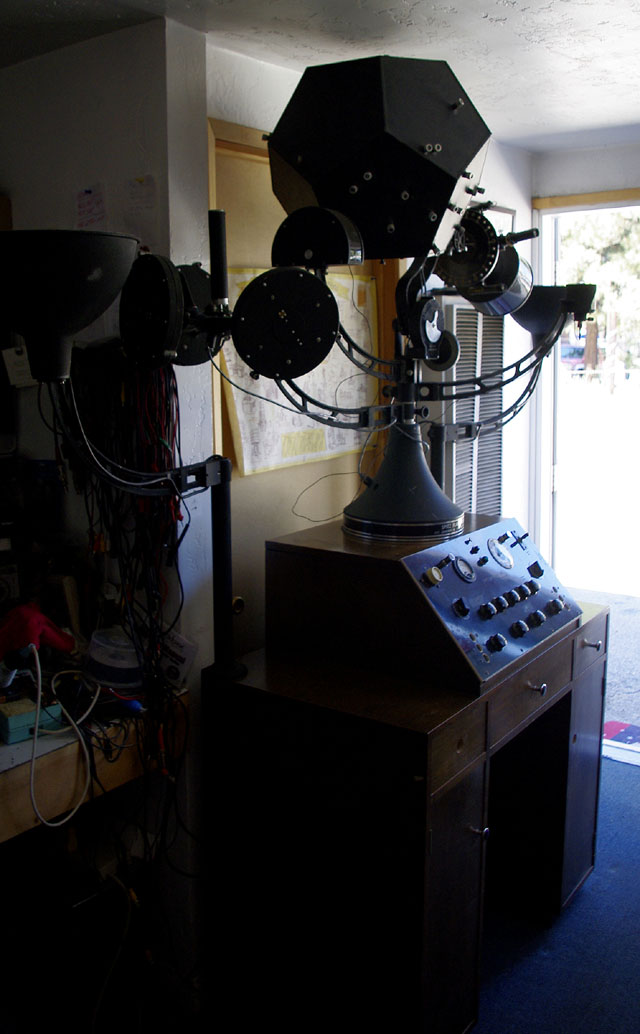
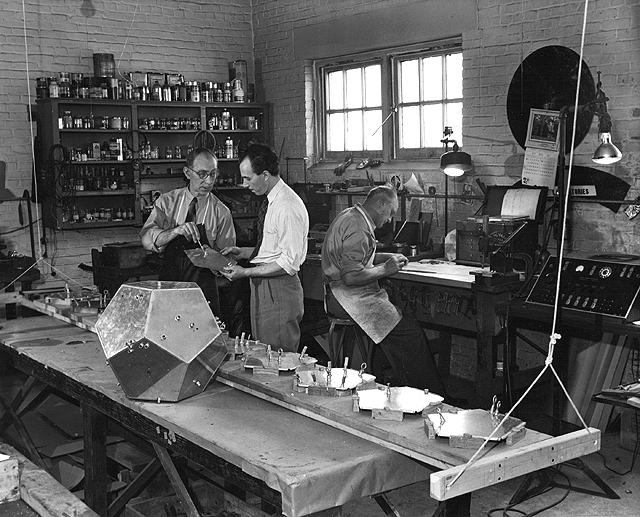
A photograph of the Spitz Factory Taken in 1954
Thanks to Planetarian Steve Russo for making the picture available!

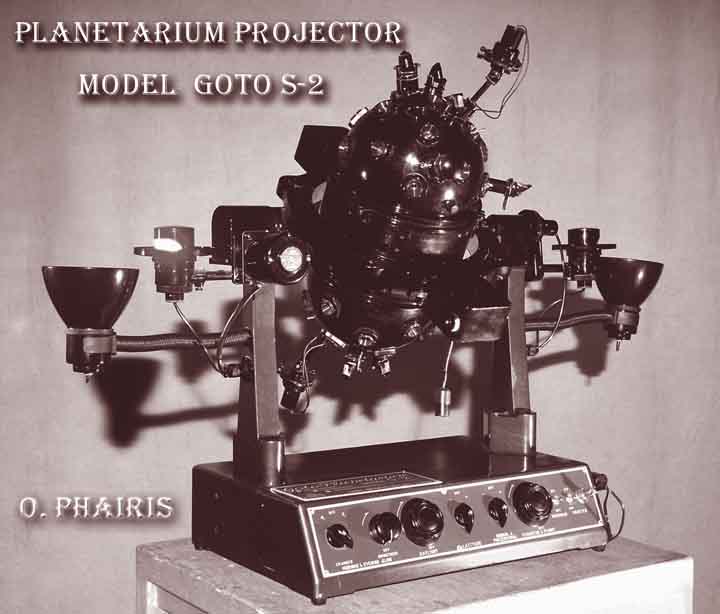
Museums' Goto S-2 Planetarium Projector
Shown here is the Museums very first projector, purchased from a private party and built in 1959. This is a fully optical projector using 32 lenses to project the stars on a 24.6 foot dome. This projector projects about 2500 stars and all the visible planets and moon phases. According to Goto records it is one of only 3!
Gallery of Goto S-2 Planetarium Projector Pictures.
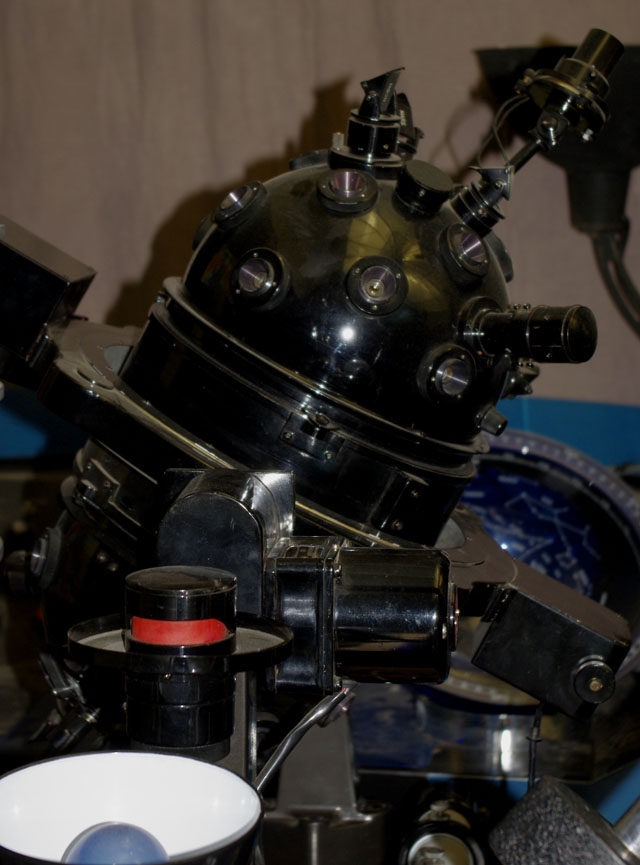
Closeup Photographs of the Museums' Goto S-2


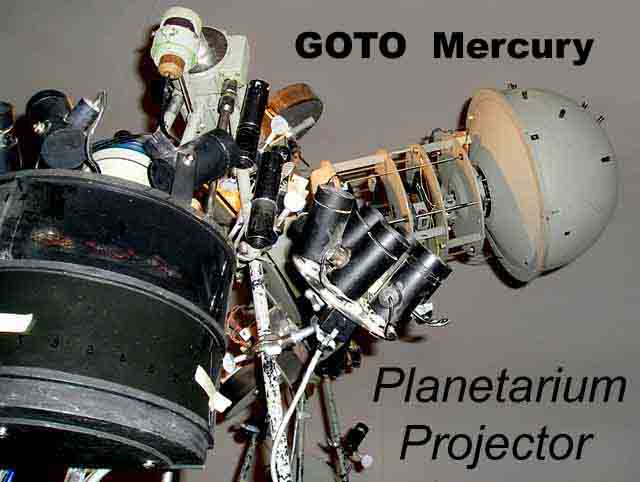
Museums' Goto Mercury Planetarium ProjectorThis historic and rare projector came from Holt Planetarium located at the Lawrence Hall of Science, UC Berkeley. The projector was built in 1965 and displays around 1800 stars. Originally it was sold to UCLA for around eight thousand dollars. In 1973 it moved to UC Berkeley where it operated until February 29th 2008 where it entertained and educated over 500,000 people before being retired. According to Goto this projector is 1 of only 12 worldwide. After a 35 year absence it has now been returned to Southern California and moved to the museum for display and occasional use. This projector has now been offically adopted by the Home Planetarium Association as their favorite planetarium projector in our collection.
Gallery of Goto Mercury Planetarium Projector Pictures.
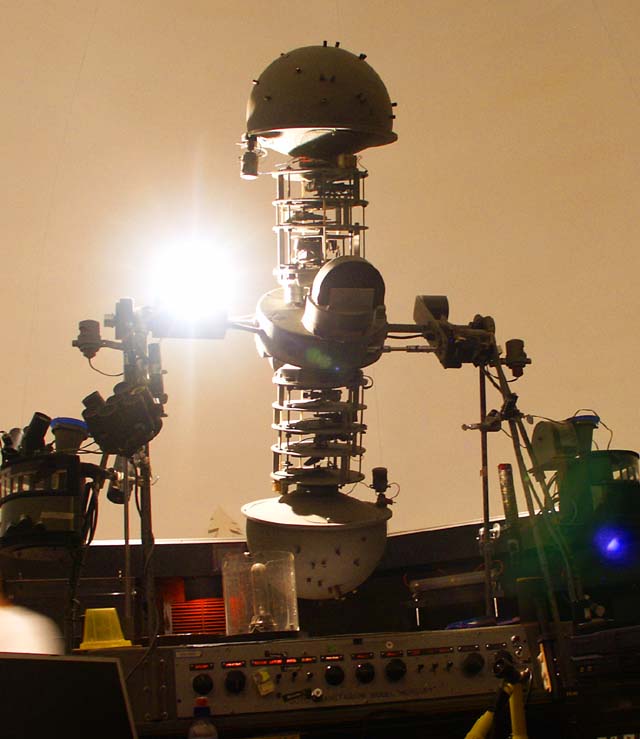
Another shot of the Goto Mercury Planetarium Projector

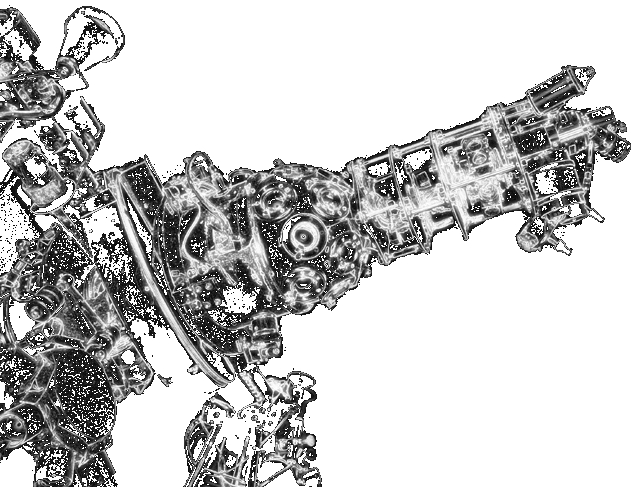

Goto Venus Planetarium Projector
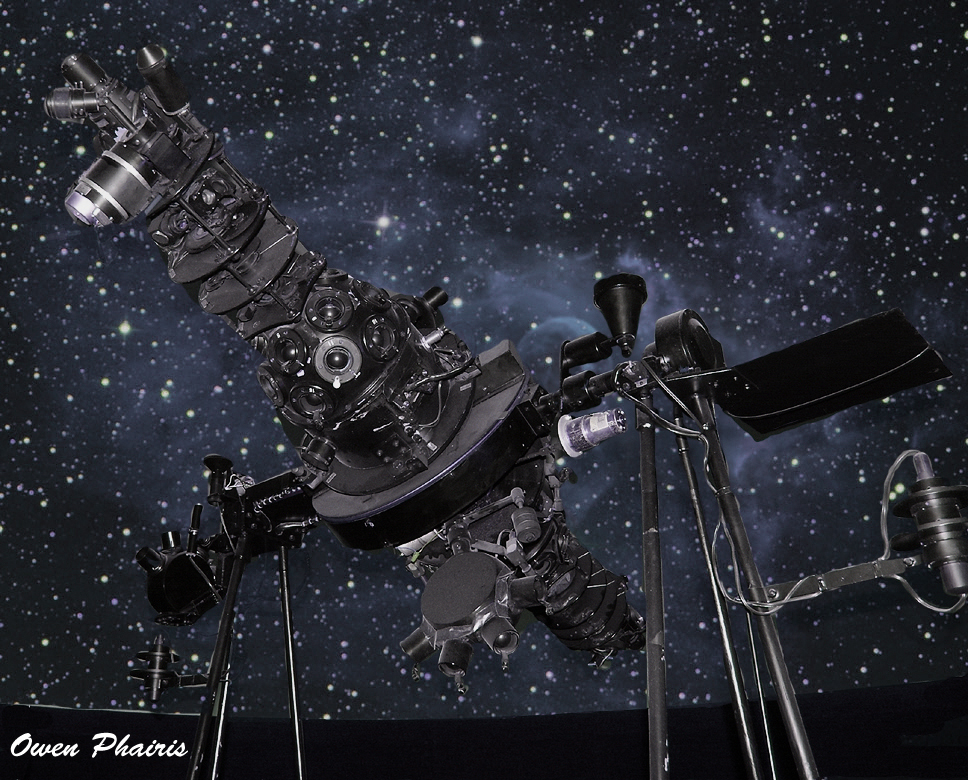
Museums' Venus Planetarium Projector
This model Venus Planetarium Projector was manufactured from 1965 thru 1974 and projects optically about 3,200 stars and was the next step up from the Mercury projector. We believe there are only about 28 of them left. Sold mostly to high schools in the USA their original selling price was around $ 7,500.00 and they were built by Goto Optical but distributed here in the states by Viewlex. This one was featured in a 2014 episode of the Disney Channel sitcom: "Jessie."
Gallery of Goto Venus Planetarium Projector Pictures.
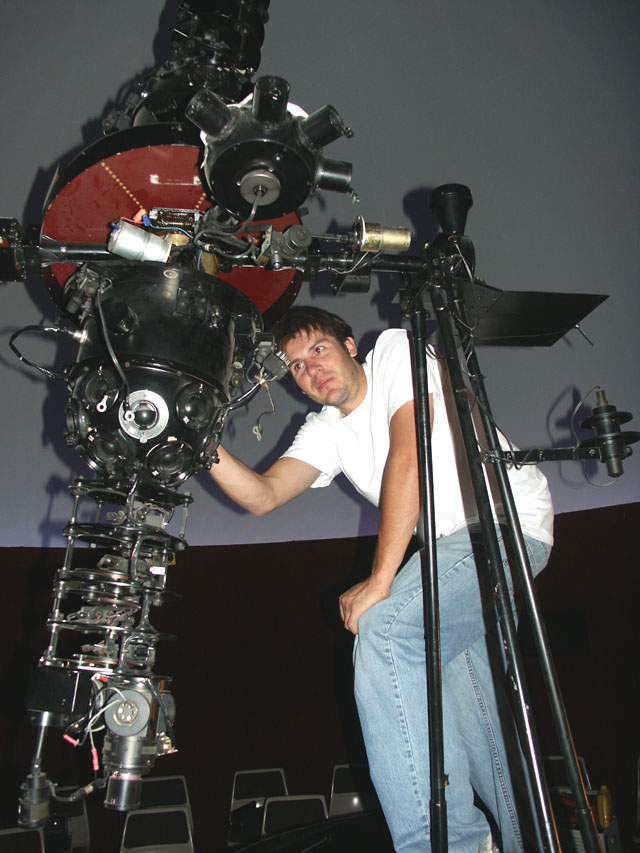
JR working on Goto Venus Planetarium Projector
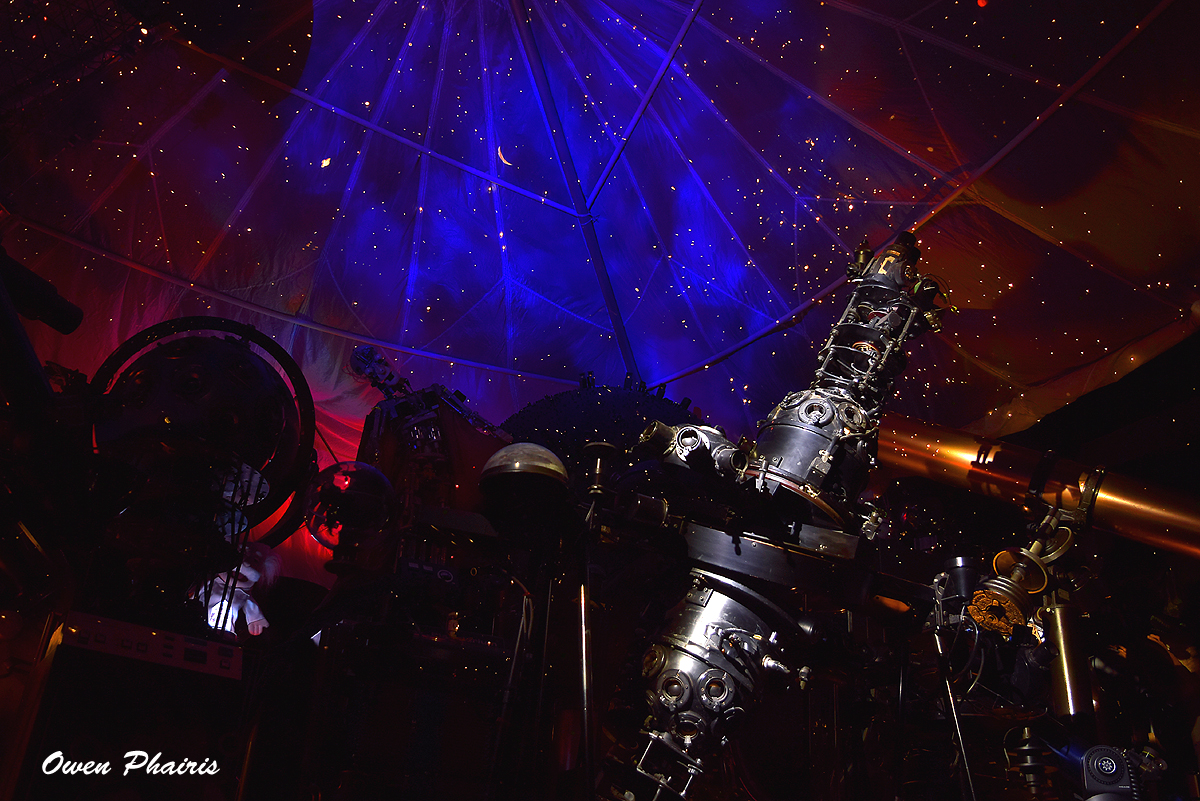

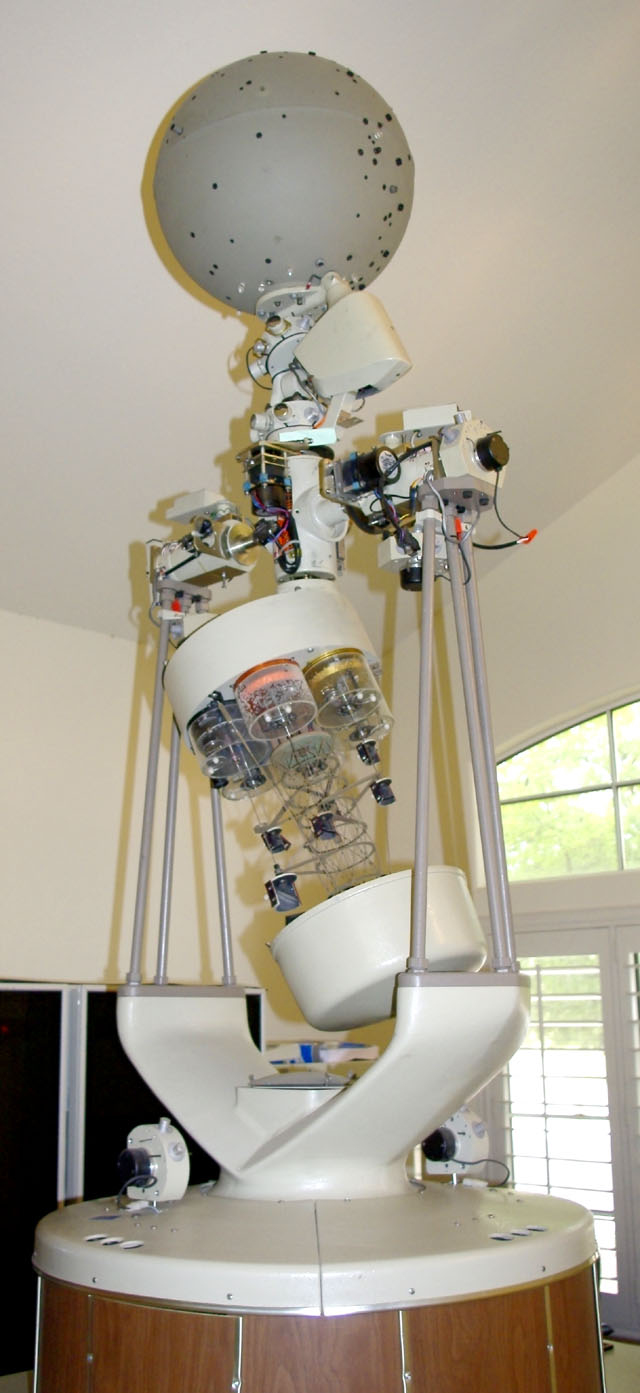
Museums' Spitz 512 Star Projector
This projector was originally sold to and used at the Lakeview Museum of Arts and Sciences in Peoria, Illinois. It was run by Planetarium Director Sheldon Schafer between 1977 to 2007. This star projector, which was affectionately known as 'Mark Spitz' is one of the Museums' newest and most modern of the planetarium projectors in the Museums collection.
Gallery of Spitz 512 Planetarium Projector Pictures.
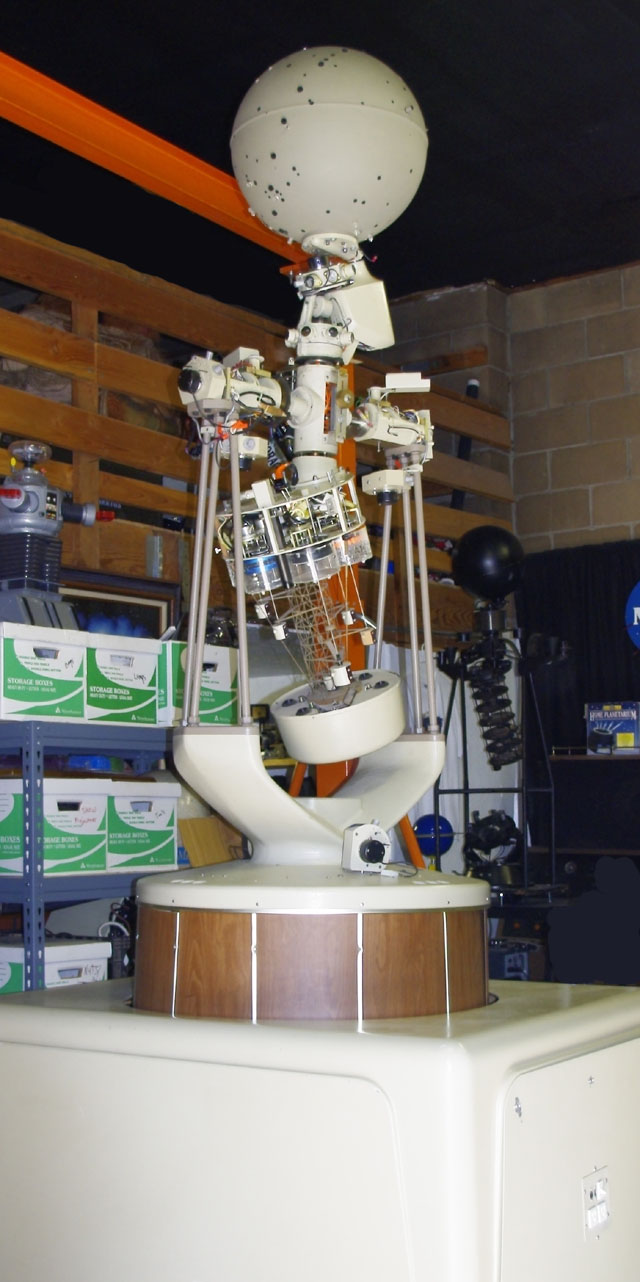

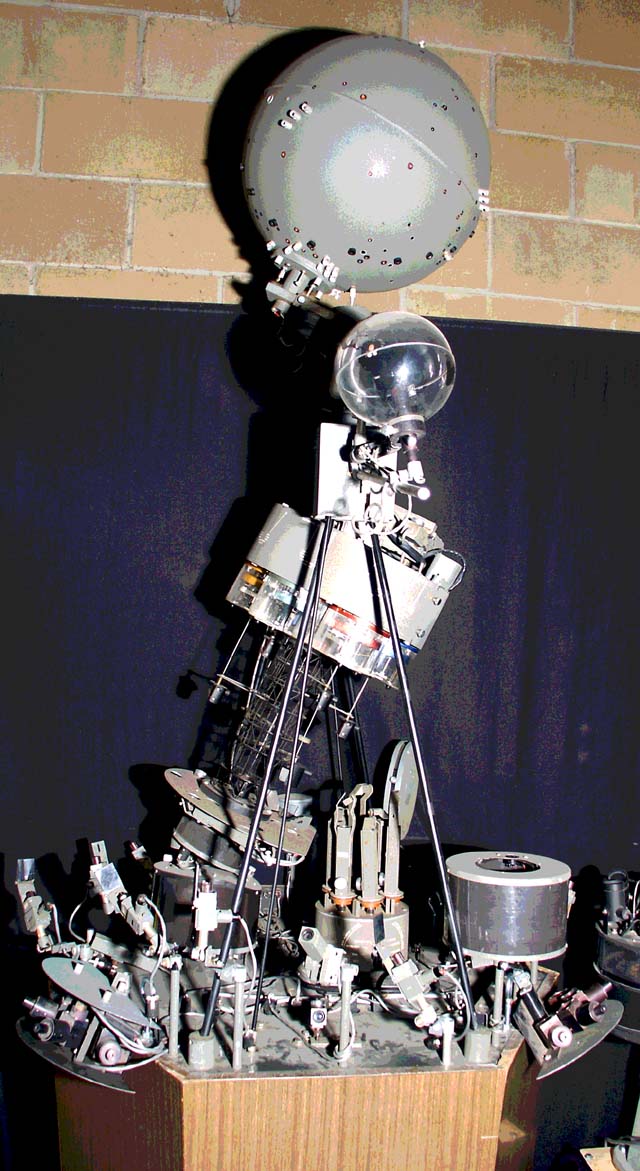
Museums' Spitz A3P Planetarium Projector
This projector was originally sold to and used in the Tessman Planetarium at Santa Anna College, California. The A3P instrument was sold mostly to colleges and schools in the 1960s and 70s. This one has a Spitz serial number of 3275. The A3P is one of the most common of all the commercial planetarium projectors ever made. It projects about 1500 stars and uses both pinholes and also lens projection for the brighter stars and was designed for a 24 to 40 foot dome. We believe there were about 500 model A3P/A4 types produced by Spitz when it was mostly replaced by the model 512/1024 in 1973.
Gallery of Spitz A3P Planetarium Projector Pictures.
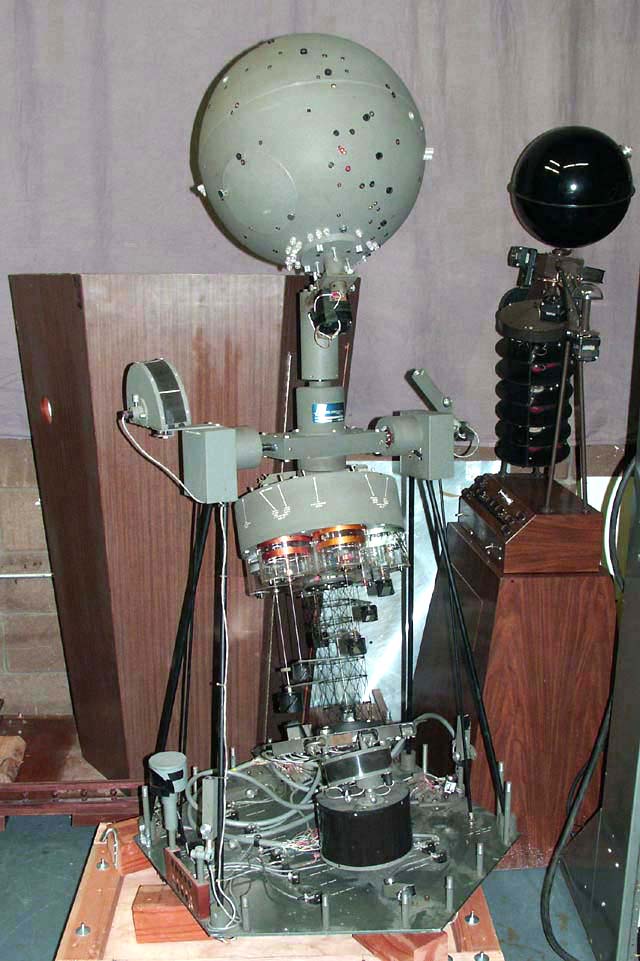
Museums' Spitz A3P and Nova Projectors

The 'Twins' equal the A3P and the 512 together


Haromic Reed Nova III
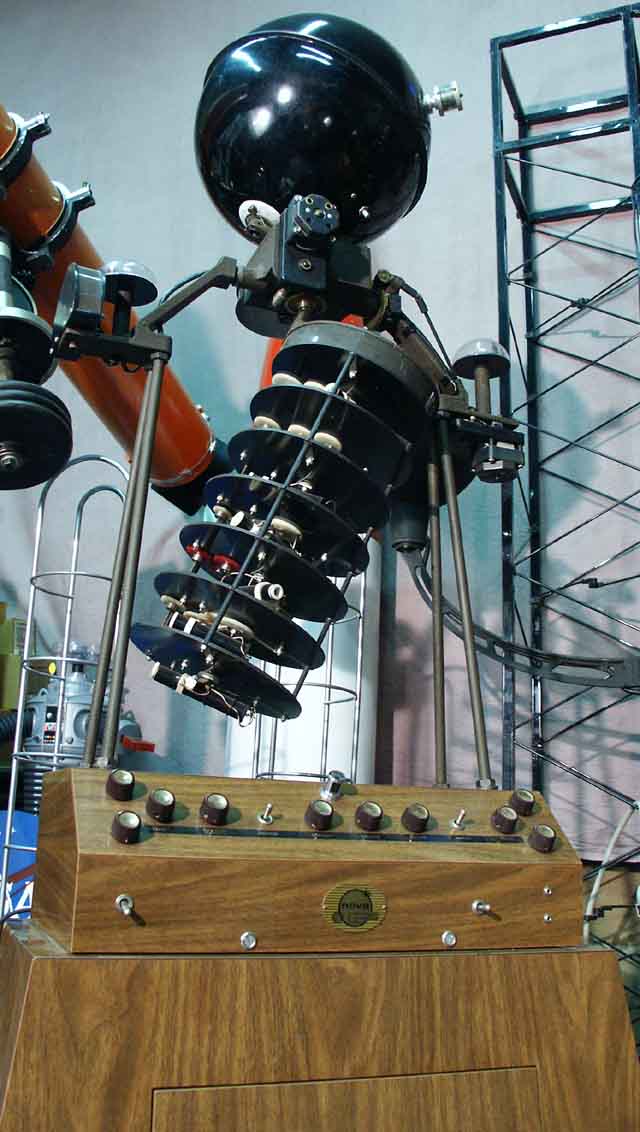
Museums' Nova III Planetarium Projector
This came to the Museum from a high school in Kentucky which was the main market for this type of projector. This projector was released in 1963 and originally sold for two thousand dollars. It was built by the Harmonic Reed Company and later by Spitz in 1972. We believe there were 200 made and it projects about 650 stars.
Gallery of Harmonic Reed Nova III Planetarium Projector Pictures.

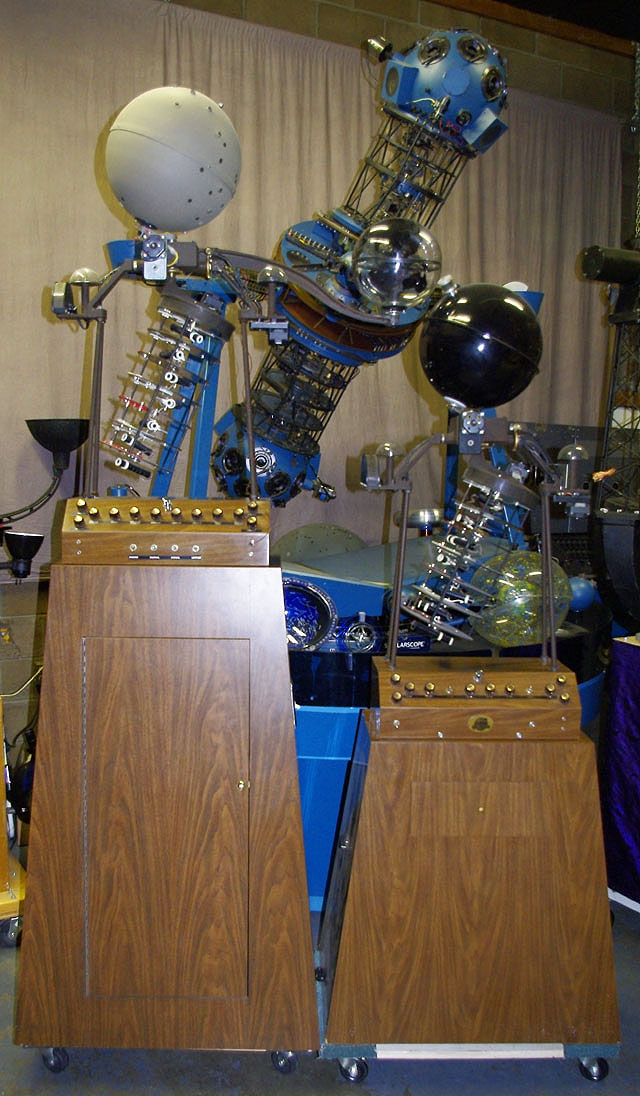
Museums' Spitz 373 next to Nova III Planetarium Projector
Pictured is the Museums' Spitz 373 right next to a Harmonic Reed Nova III. When Spitz bought out Harmonic Reed in 1972 they made several needed improvements to the projector. This included a new and better all metal starball with lenses for the brighter stars to replace the plastic starball used by Harmonic Reed. They also replaced the weak filament lamp in the Nova with a brighter arc lamp used in their other Spitz projectors. They also made the base taller and added a geo-centric earth. We believe that Spitz sold 200 units of this model planetarium projector. This Spitz 373 planetarium projector was beleived to be owned at one time by the University of Iowa.
Gallery of Spitz 373 Planetarium Projector Pictures.


Goto E-5 Planetarium Projector

Museums' Goto E-5 Planetarium Projector
This planetarium projector arrived at the Museum in late December 2008. This projector comes from Mr. Jon Elvert and is one of about 300 made and projects around 650 stars. This projector has a strong resemblence to the Harmonic Reed Nova III and was also introduced during the 1960s.
Gallery of Goto E-5 Planetarium Projector Pictures.
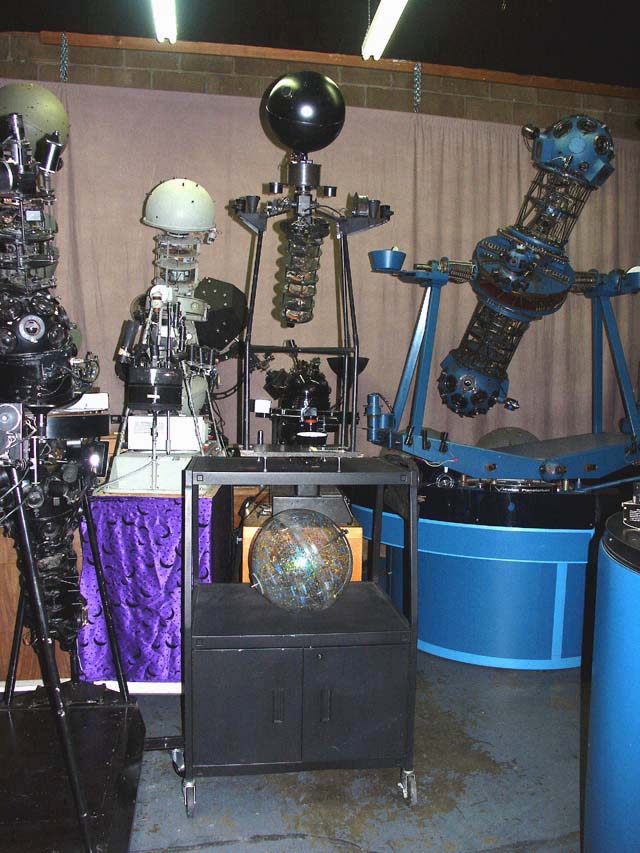
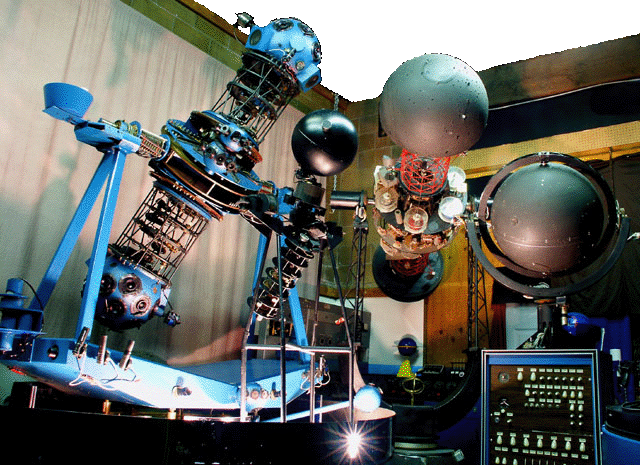

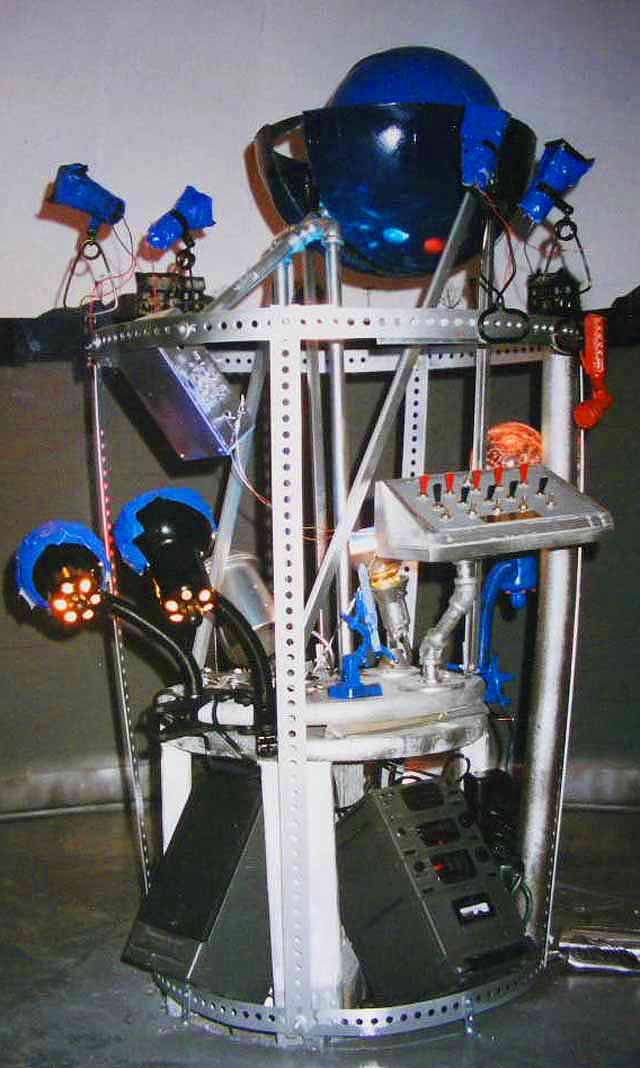
Museums' Emmons HPA Planetarium Projector
This one of a kind projector has been donated to the museum from the Home Planetarium Association and Mr. Gary Likert. The projector was built in 1995 and features the second to the last Emmons starball ever produced. This projector will provide inspiration and serves as an excellent example of what can be done in the home by talented individuals. This projector is continually undergoing reconstruction and we post new pictures frequently. When completed this machine will then proudly take its place along side the commercial planetarium projectors and take its place in history as well.
Gallery of HPA Planetarium Projector Pictures.
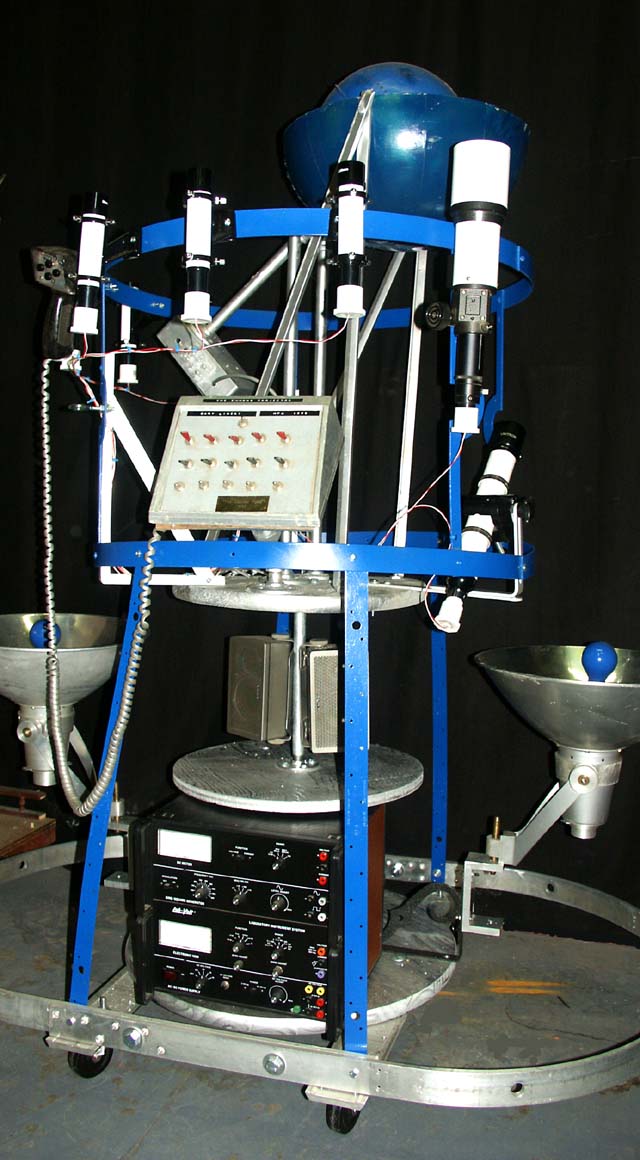
Museums' Emmons HPA Projector as it appears today 10/12/2008

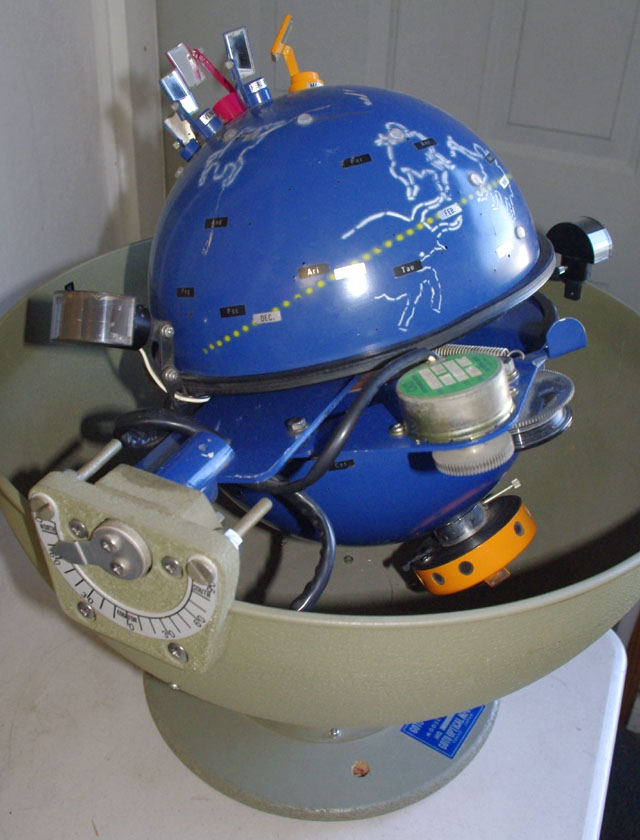
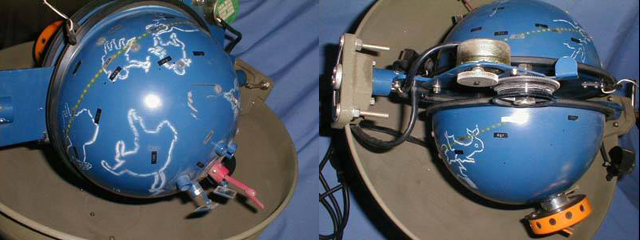
Museums' Goto EX-3 Planetarium Projector
The Goto EX-3 was designed as a teaching tool for schools and has been manufactured since at least 1973. The EX-3 projects 500 stars and requires only a ten foot portable dome or a very large umbrella which made it ideal for the classroom.
Gallery of Goto EX3 Planetarium Projector Pictures.

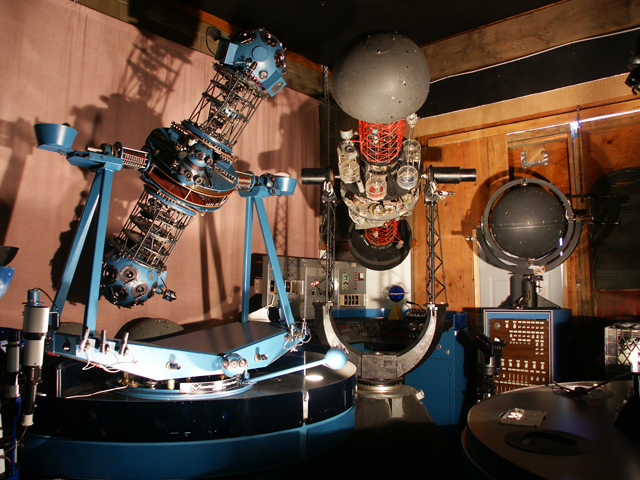

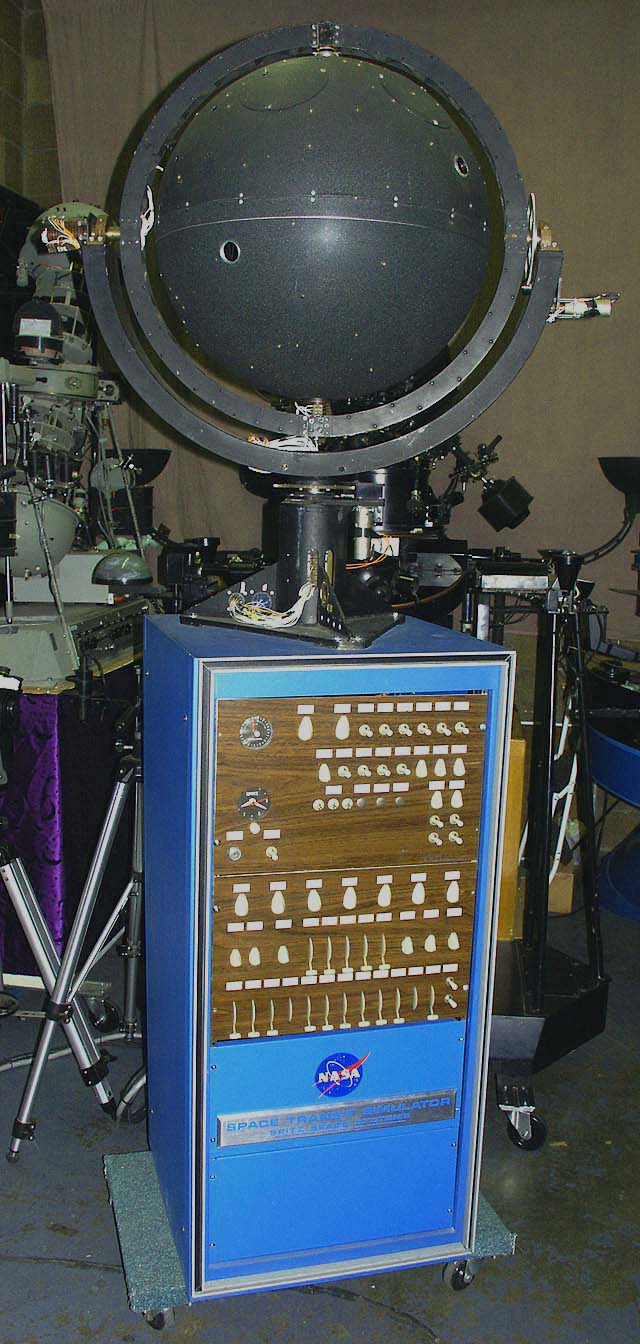

Museums' Spitz-NASA Apollo Space Program ProjectorThis one of a kind projector was built by Spitz under contract from NASA for the Apollo Space Program. The projector was computer controlled to recreate space craft movements in space and to simulate a trip to the moon. The projector was sent to MIT which in turn made the navigation computer for the Apollo Project. After the Apollo Program ended it was sent to Boston University where it served as their planetarium projector for 20 years. The projector is capable of projecting close to 3,000 stars and has a 24 inch starball which may be the largest pinhole starball ever made. This also served as the prototype for the Spitz STS planetarium projector. Due to the historical significance of this planetarium projector the museum was indeed fortunate to be able to purchase it and would like to thank Steve Pielock for the background information and also his help in obtaining it.
Gallery of Spitz STS Planetarium Projector Pictures.

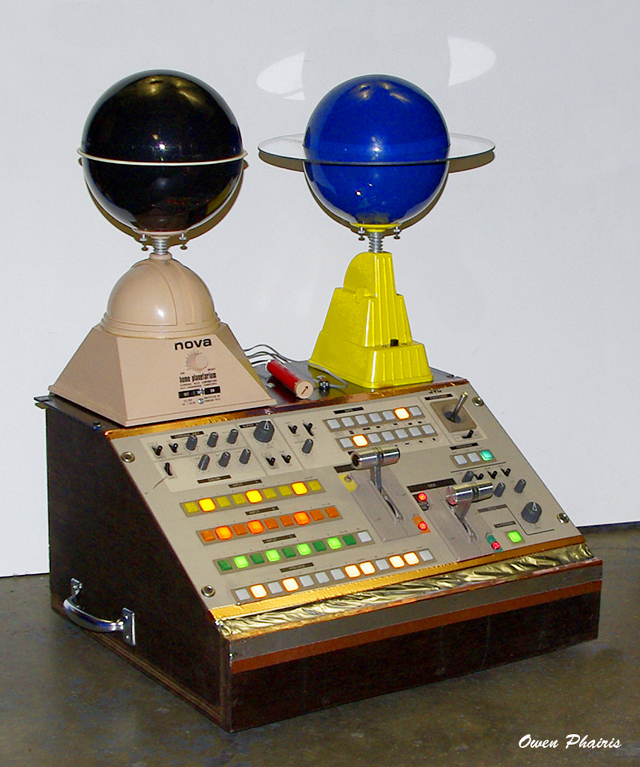
Some of the Museums' Toy Planetariums
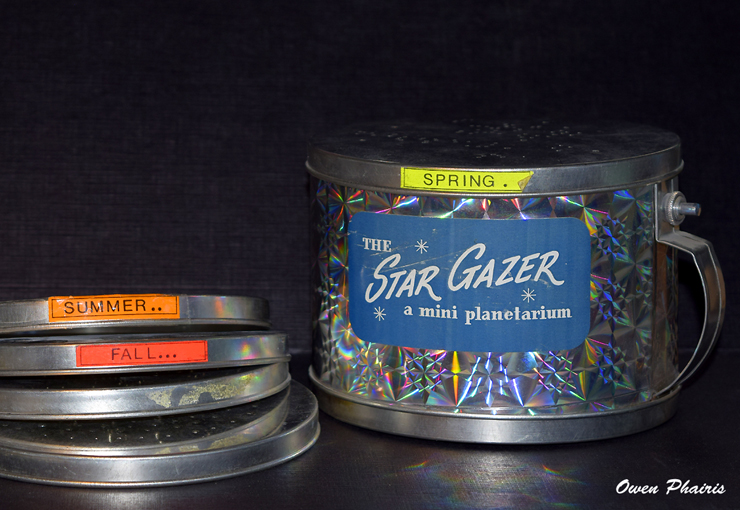


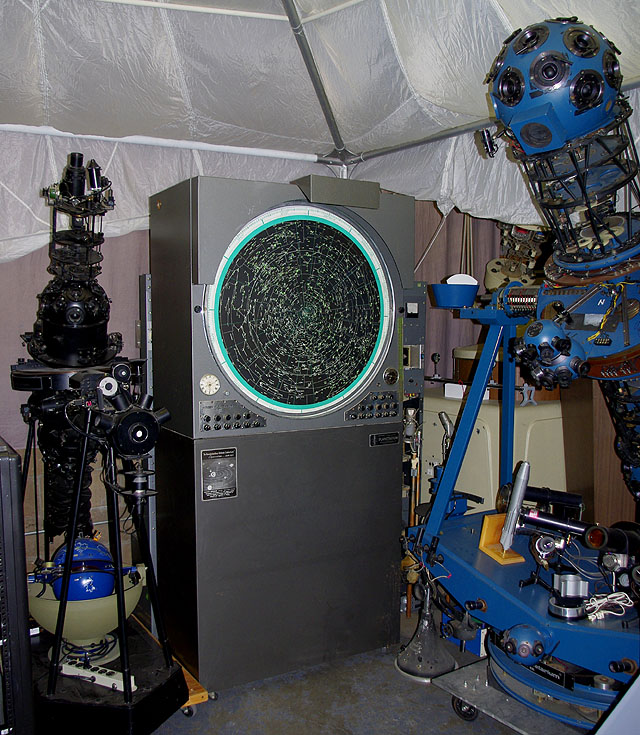

Dr. Mussers' Personal Copernican Planetarium Prototype
Again, In our continuing effort to preserve our rich planetarium heritage, the Museum is proud to announce that we have acquired Dr. Mussers' original
Copernican Planetarium Prototype built in 1958 during the International Geophysical Year. The planetarium, which was invented and developed by Dr. Clair O. Musser of Scientific Space Industries, which was a subsidiary of Hughes Aircraft Company at the time, was ideal for classroom use. A lecturer could control the black light, read from the calendar clock, set the time register, attenuate the sun, planets and asteroids, control the planets individually, control orbital speeds, reverse orbital movements and produce eclipsing binary effects. The Planetary System is portrayed in color and includes each of the nine major planets, the moon, the region of the asteroids, and the sun. A separate light source produces each of the objects shown, generally by rear projection from inside the cabinet onto the surface of the translucent viewing screen. Each object is controlled by a separate electrical circuit with provision for dimming, so that a lecturer can show only those objects which were required for his demonstration. We believe less than 50 of these were made by Scientific Instruments of Los Angeles and distributed by Central Scientific Company (Cenco) of Chicago. They were sold mostly to Planetariums, Museums, and Institutions during the 1960s for around $ 6,000 and it stands seven feet tall when it is on its stand which holds its interchangeable disks. A smaller home version was also manufactured and sold to individuals reportedly at the 1962 Worlds Fair in Seattle Washington. The Museum is indeed fortunate to have acquired this historic instrument which is another piece of our fascinating planetarium heritage!
Gallery of Muser Planetarium Pictures.




Museums' NASA Electron MicroscopeEver wonder what happened to the RCA electron microscope that was used by Dr. Delbert E. Philpott to check the Apollo moon rock samples for life? Well, it has arrived here at the Museum in late April 2009 along with space flown samples. More pictures and details will follow.
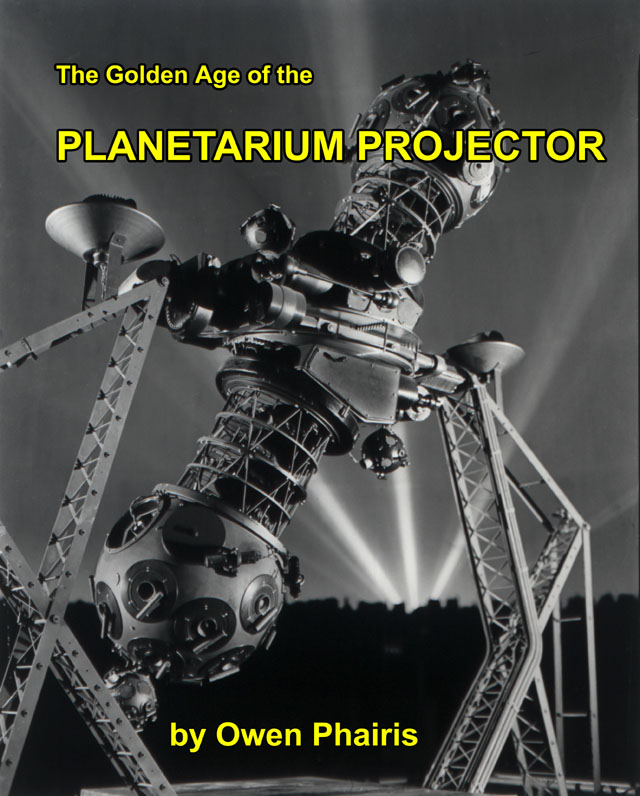
We are Considering a new Book Project?
A picture book of planetarium projectors and planetaria. Do you have pictures to contribute?
Please be sure and check out the pictures in the Planetarium Picture Scrap Book pages of this website.

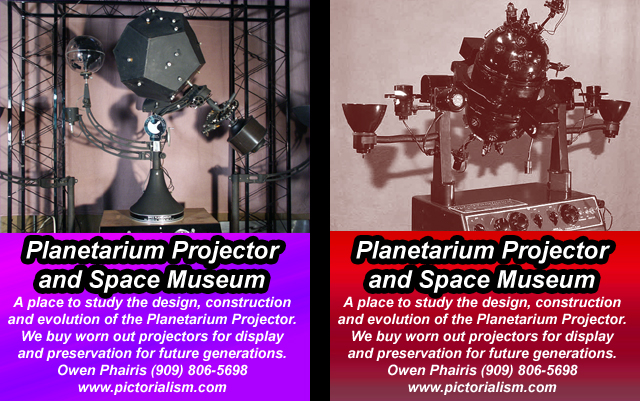
Spring and Summer 2008 ads placed in: "The Great Western Observer"There are also articles on pages 16 and 31 about the Museum.
Index of issues may be found here: "Great Western Observer Index"Museums Fall ad and Winter 2008 ads for GWO are below:
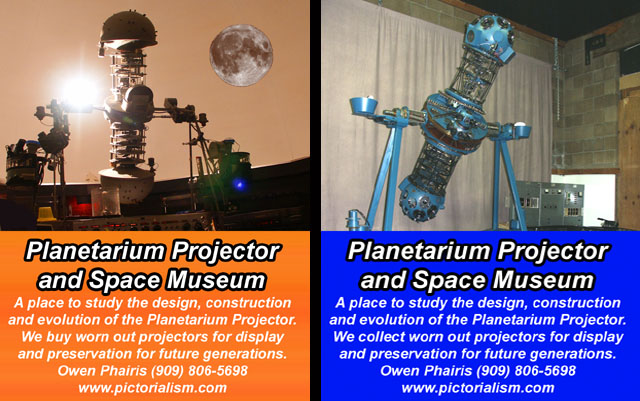
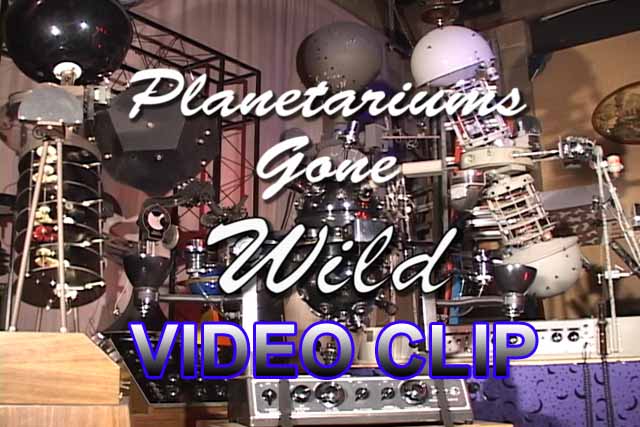
PLANETARIUMS GONE WILD
Short 60 Second Video Clip
Demonstration of the movements of the Goto S-2 and Mercury Projectors.
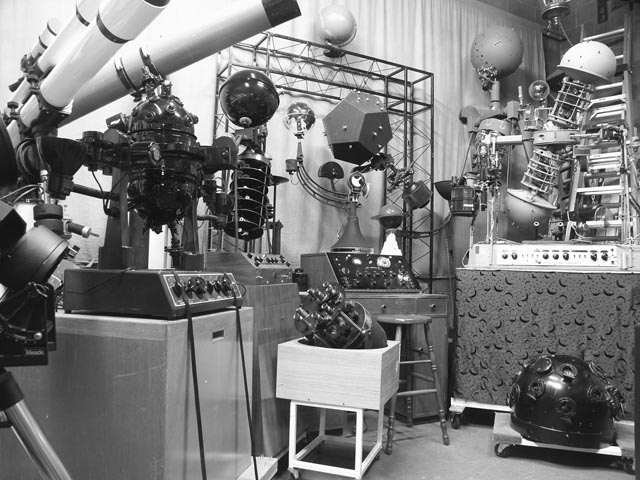

The Museums' 138 pound Nickel/Iron Meteorite
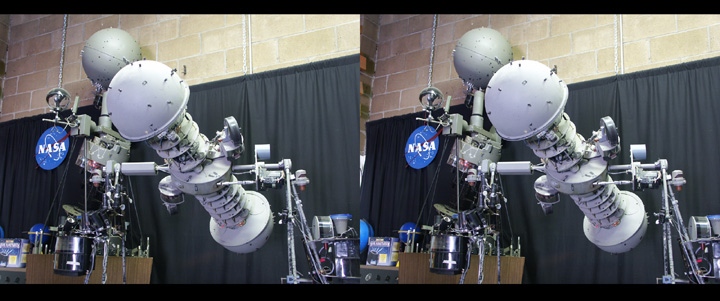
A 3-D Stereo Photograph
Crossed eyed viewing - Look at left image with right eye and right image with left eye.
A third 3-D color stereo image will form in center.

A 3-D Stereo Photograph

This 3-D anaglyph image requires standard Red (left eye) / Blue (right eye) 3-D glasses.
More exciting 3-D projector images can be found here:
3-D Stereo Planetarium Projectors

MUSEUM EXHIBTS MAY INCLUDE:

Member: Pacific Planetarium Association
Member: Bear Valley Astronomical Association
Member: Rocky Mountain Planetarium Association


INTERESTED in Planetarium History?
Check out these links:

Please click on the picture scrapbook link below for the latest updates as well as many more interesting
photographs. We believe that almost all photographs on this site are copyright free and may be copied and used freely to advance interest in Science, Engineering, Astronomy and Planetariums everywhere. Please check with us to verify before publication and for credit information. In many cases higher resolution images may be available.
Please call Owen at 909-806-5698 for more information or at: ophairis[at]hotmail.com.

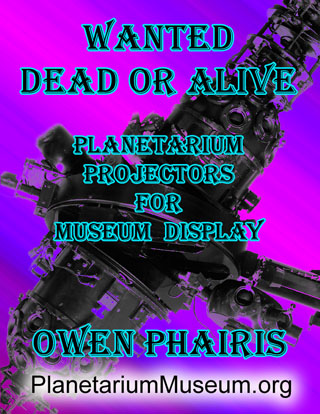
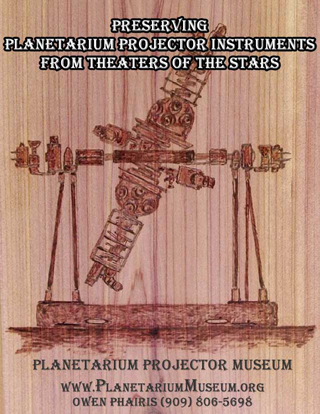
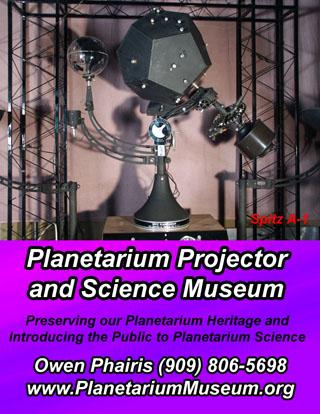
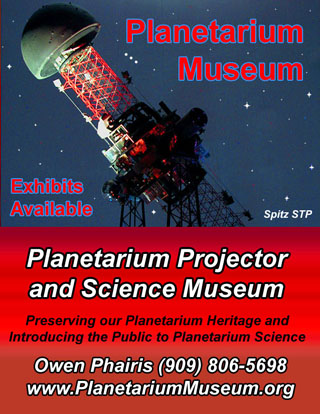 2009 and 2010 Great Western Observer Ads
2009 and 2010 Great Western Observer Ads

Have a Planetarium Projector to Donate or Sell Us?
Please feel free to contact Owen Phairis at: ophairis[at]hotmail.com
Owen Phairis, P.O. Box 3400, Big Bear Lake, California 92315
(909) 806-5698



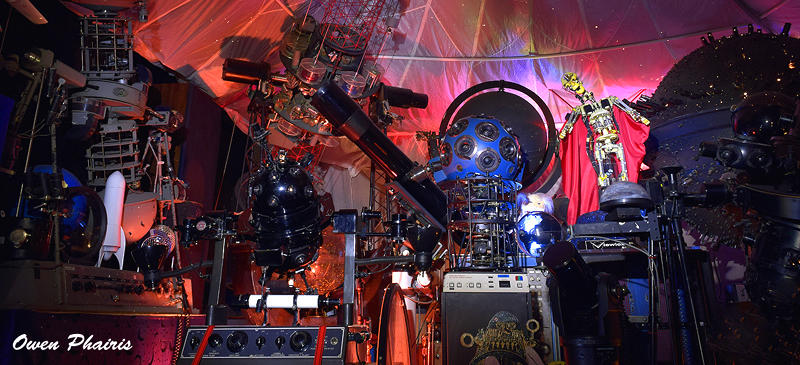

Now showing in our Planetarium:
Captain Corona and the "Overcast of Doom"
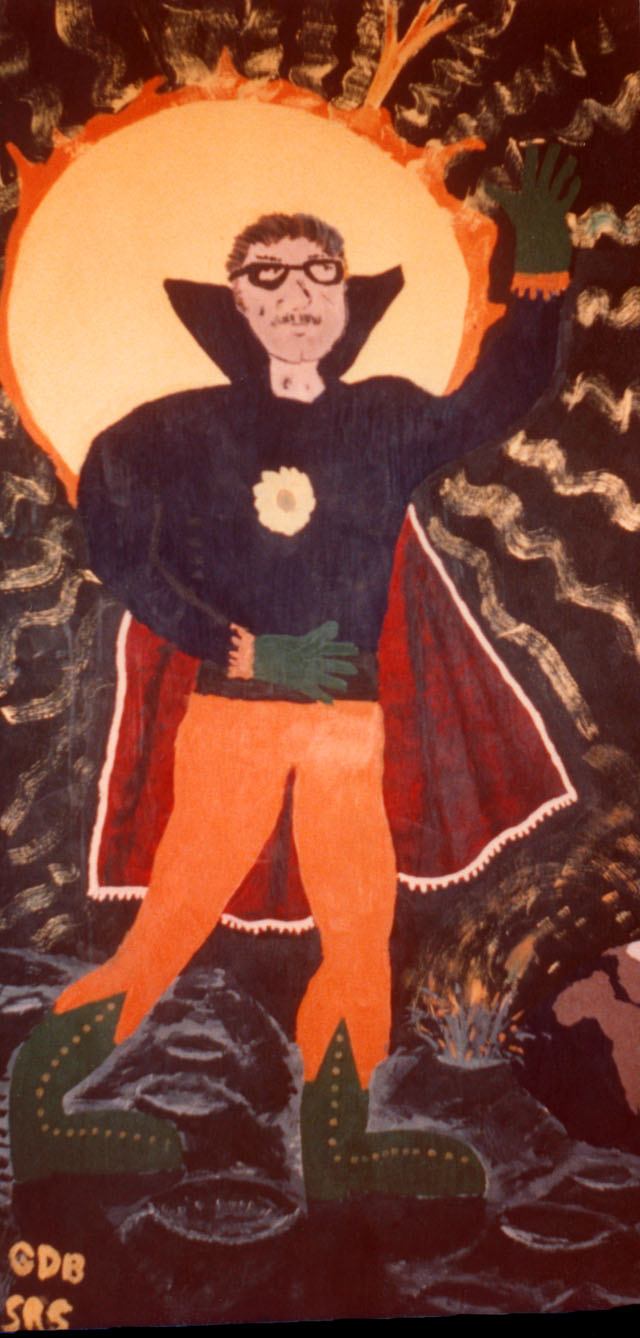
Captain Corona - Action Hero and the Guardian of Sunlight
Now appearing in the "Overcast of Doom"
This painting of 'Captain Corona' was done in the early 1970s by famous Science Fiction Author David Brin while he was a student at Cal-Tech. Thanks to recent information provided by Bob Sills we now know that Captain Corona was the creation of Caltech student Dick Trtek and was based on Cal-Tech Professor Dr. Harold Zirin (1929-2012).
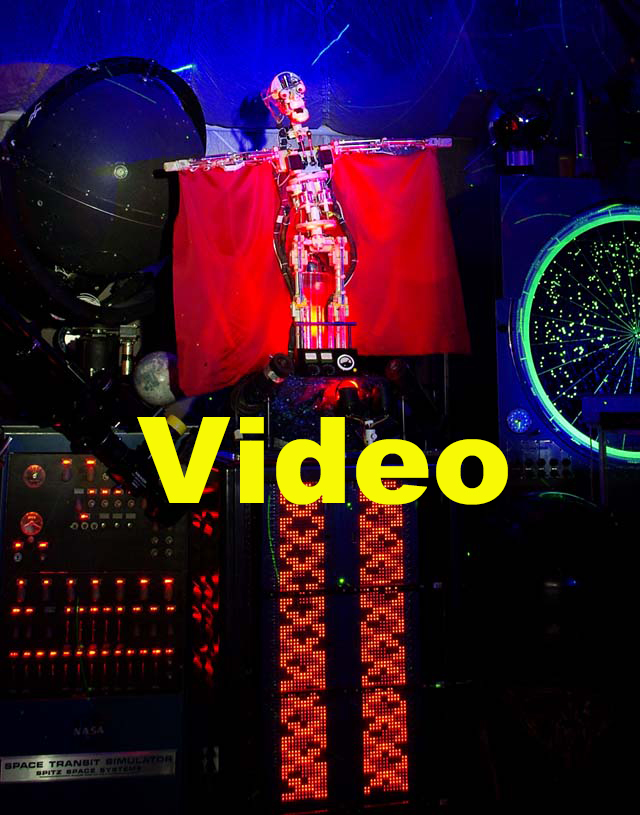
Our Robot, Copernicus, introduces our shows and plays 'Captain Corona'
Click on picture above to see Video of the Introduction
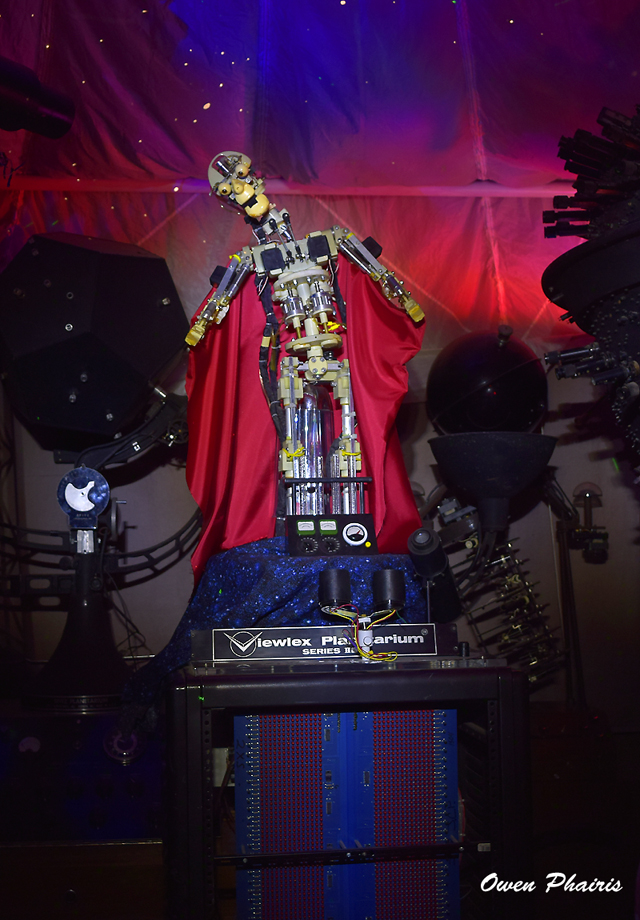
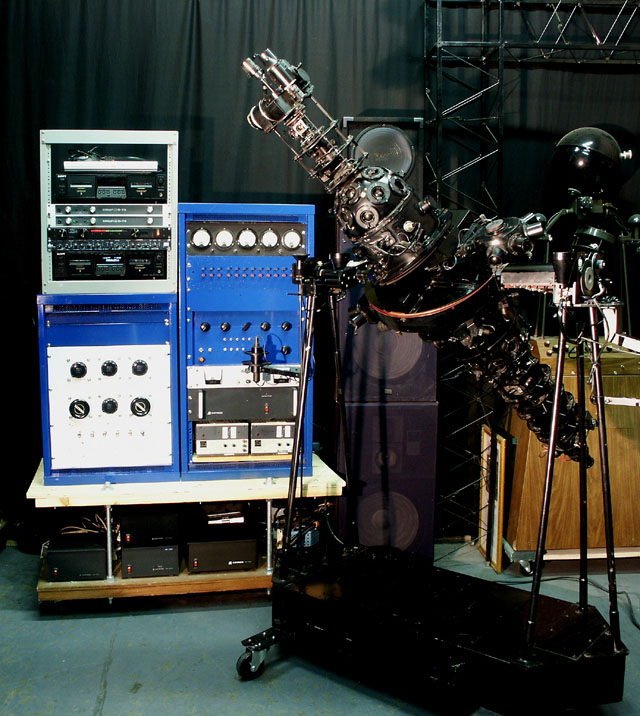
Venus Planetarium Projector currently used for our planetarium shows
Another Planetarium show available: "Flying Saucers and UFOs"
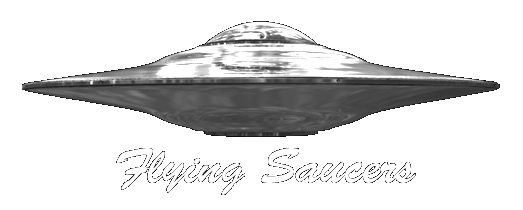
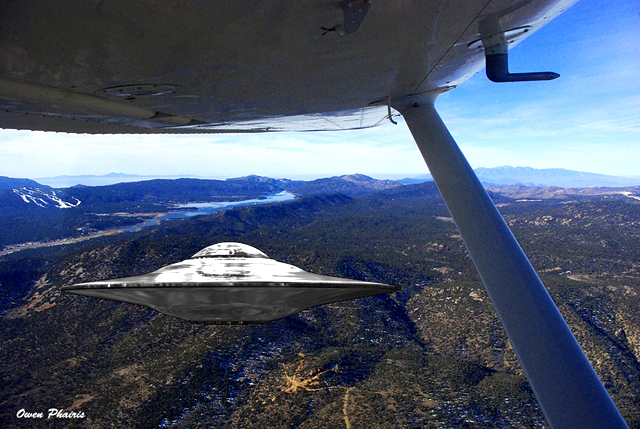
Also available by special arangement:
"ASTROLOGY - and the Signs of the Zodiac"

Now Showing in our proud sister Planetarium located in Gallatin, Tennessee:
Under EGYPTIAN Skies - the Ghost of Khufu!
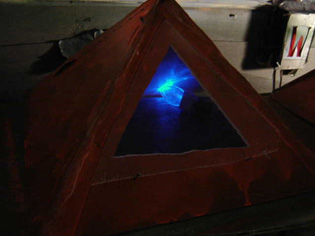
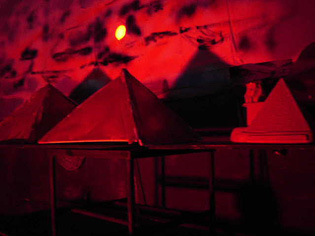

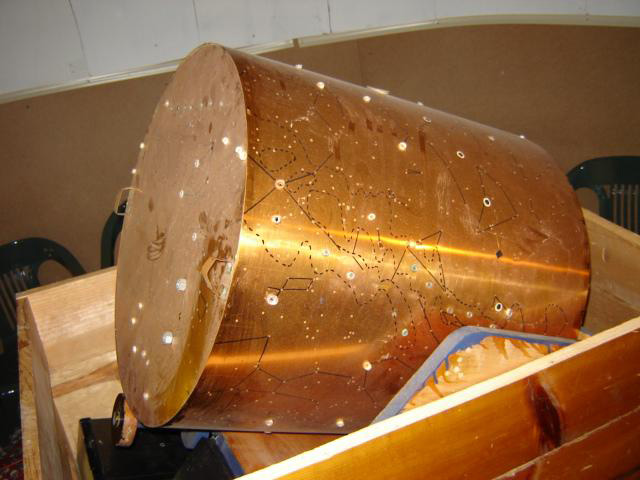

Steve Smith Star Cylinder in use at the Sumner Star Theater


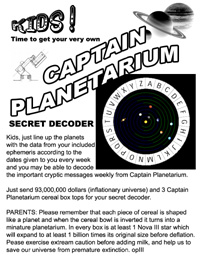
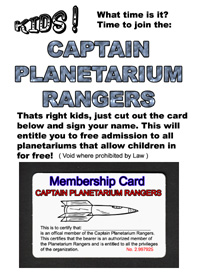
Just for FUN - "The Adventures of CAPTAIN PLANETARIUM"
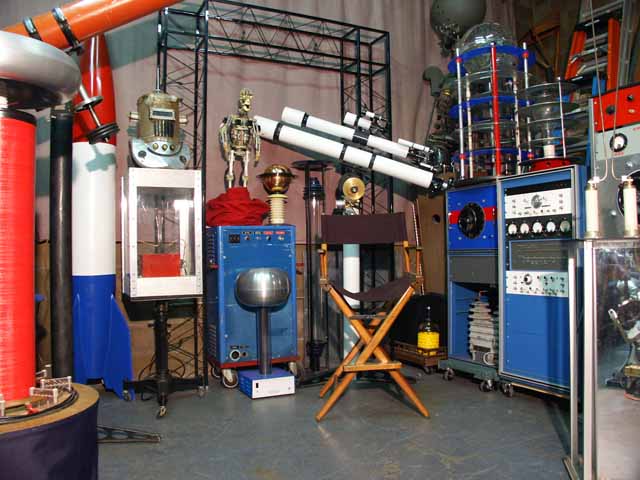
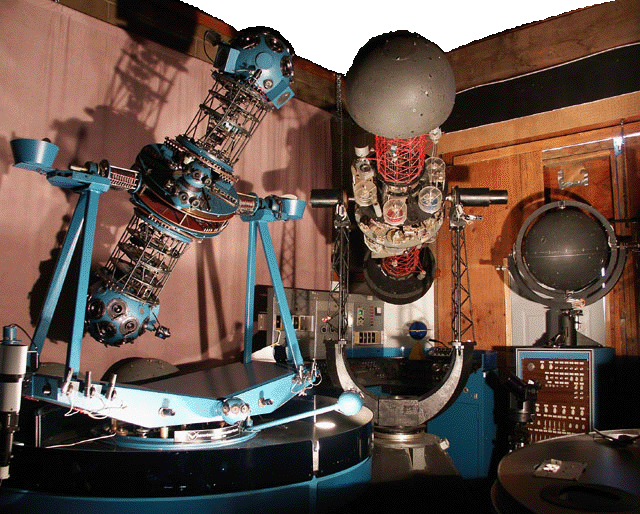
"From the optical wizardries of industrial giants to your corner hardware store -
- from scientific legends to enthusiasts tinkering in garages and barns ..
.. these worlds meet, mingle, and all share one common purpose - the stars."
Gary Likert - Home Planetarium Association

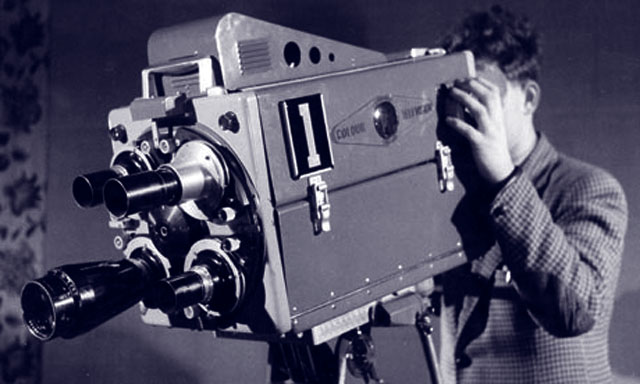
Tv Credits for Owen Phairis

Aviation Photos by Owen Phairis
Owens Old Lightning Show website
Camera Collection
Microscope Collection
Historic Microphone Collection
Seattle Space Needle Collection
Laboratory Glassware Collection
Optical Laboratory
Sherlock Holmes Collection
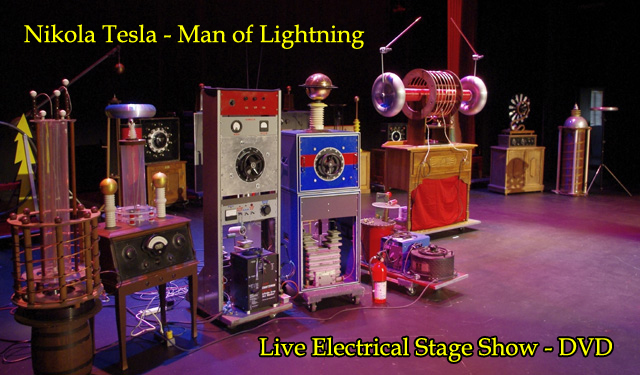
DVD on Life of Nikola Tesla helps fund the Museum

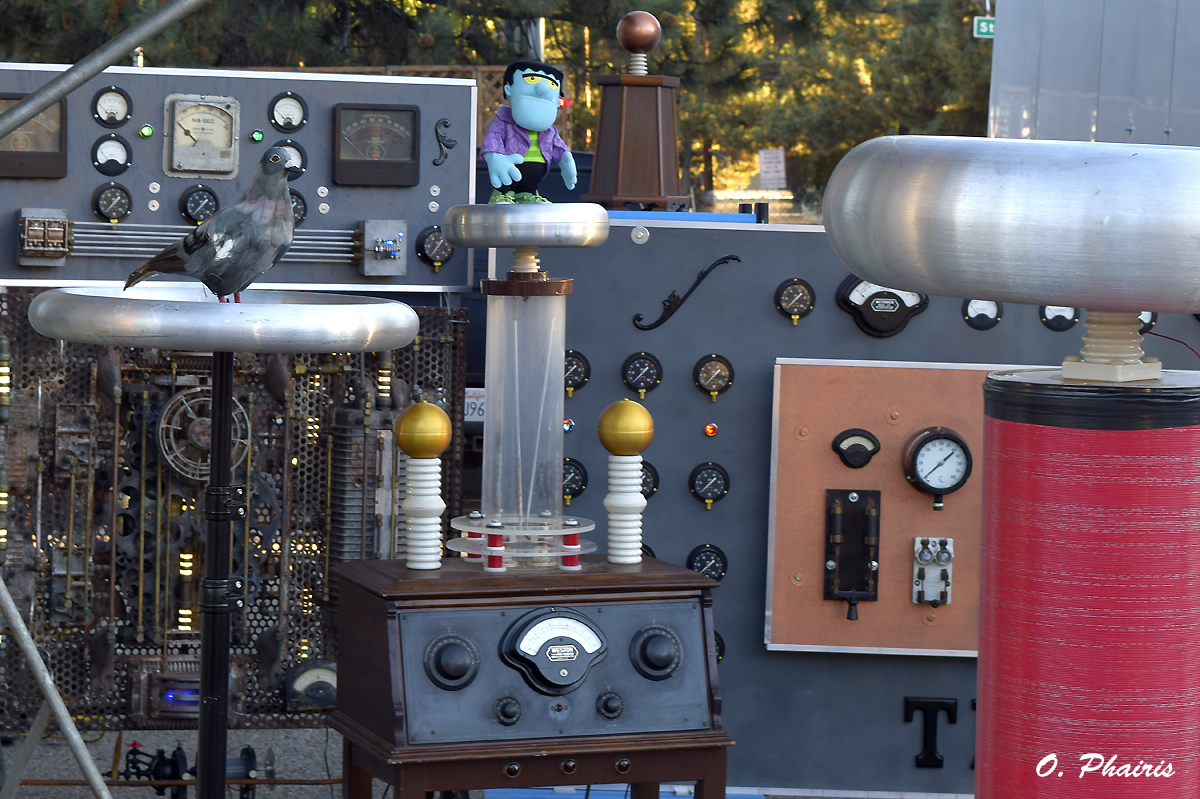
Owen is reviving his Tesla Steampunk Electrical Stage Show!


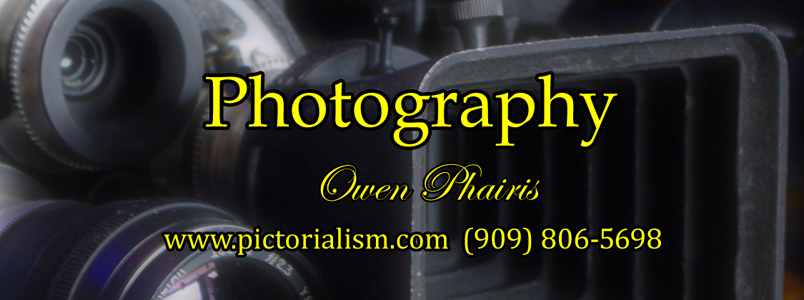
Photographic Portraits by Owen Phairis

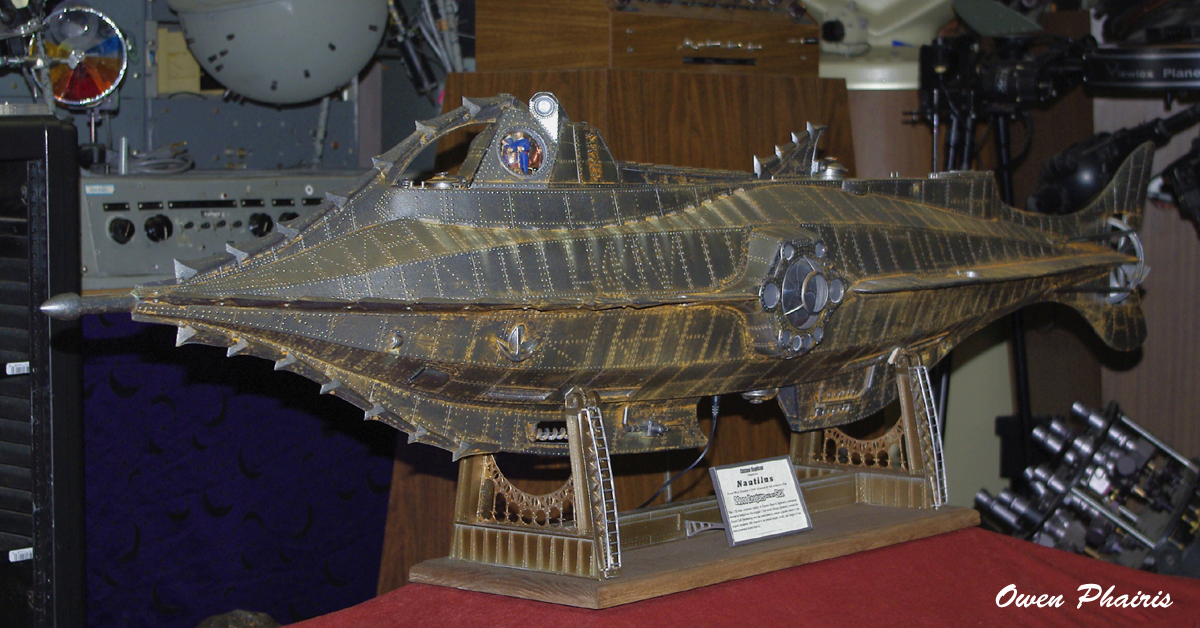

"...and all of this shall come to pass, in Gods' good time." - Captain Nemo
Owen Phairis, P.O. Box 3400, Big Bear Lake, CA 92315

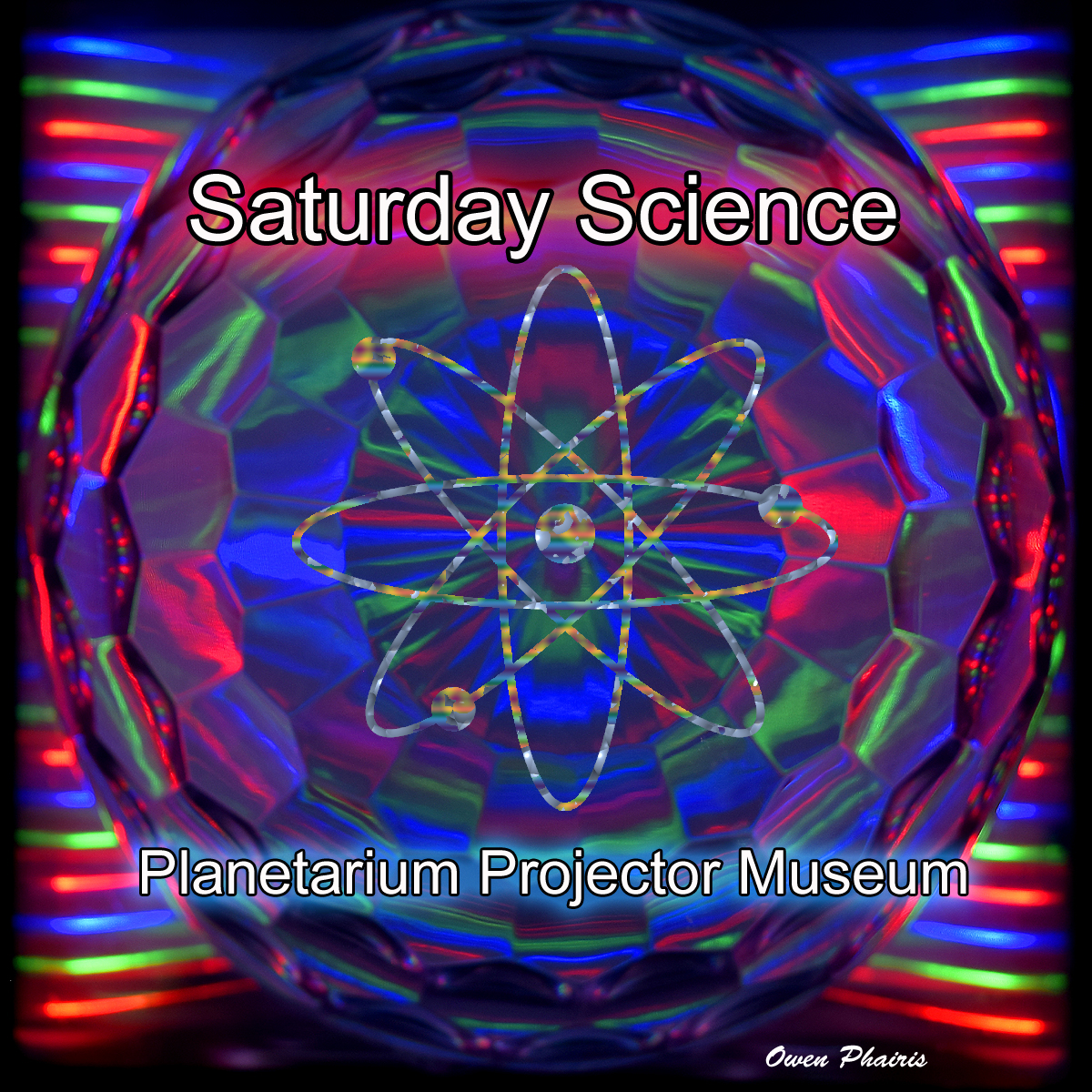
Smashing Atoms while you wait, and Liberating Photons in the Process


























































































































































































